
The Bottom Line
Introduction, Specifications, and Pricing
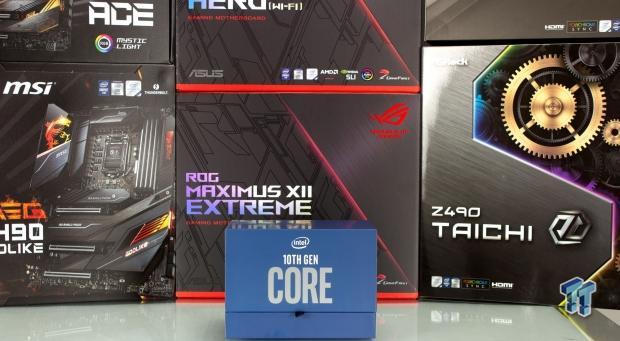
Intel's new 10th generation desktop CPUs are here. Codenamed Comet Lake is the latest offering replacing the 9000 series comet lake refresh of CPUs. However, the fact that these new series is 10th gen does not mean that it is the much-anticipated 10nm based CPU options. Ice Lake is still only lightly deployed on some mobile parts but not on desktop. Intel has really squeezed the 14nm node for all its worth it seems, like clock speed increases and scaling core counts are starting to reach the edge of what can fit on the package and still be adequately cooled.
The CPUs we have in hand today is the new top-end Core i9 10900K and the Core i5 10600K. This should give us a good view of the new comet lake stack of options from both the top and middle of the stack options.
Specifications
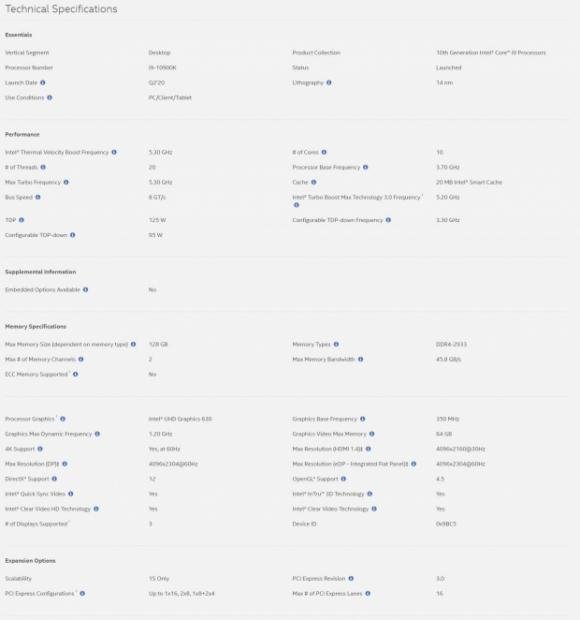

First up, we will be looking at the 10900K, which is the halo product or the top dog of the comet lake desktop chips. The 10900K comes equipped with ten cores, and HT enabled for up to twenty threads. This CPU generation also signifies the official increase to the stated TDP, up to 125W.
The 10900K also supports the new Turbo boost 3.0, which we are familiar with from X299, and it makes a debut here. Another feature set is TVB or thermal velocity boost, which uses the available thermal and power headroom to allow the CPUs best-judged cores to reach up to 5.3GHz for short bursts. The default intel defined spec for the turbo boosting of the 10900K is PL1 of 125W; the PL2 is 250W with a tau of 56 seconds. This means that the 10900K can breach the standard 125W rating for a 2x boost to 250W for up to 56 seconds.
This information may be useful in the upcoming motherboard reviews as we will be assessing their performance and if they follow the standard intel guidance on the PL1 and PL2 settings along with TAU duration. Memory on the 10900K moves up to 2933MHz, which is nice, but we all know that it is an arbitrary number since the IMC on the much older 8700K could easily surpass that speed quite easily.
The CPU does not come with a boxed thermal solution, much like many of the intel CPUs for the past few generations. Also worth noting is that the PCIe lanes from the Comet Lake-based CPUs are still Gen 3, even though the accompanying Z490 boards are largely touted with PCIe gen 4 capabilities and noted for future CPUs. This means that the next-gen rumored Rocket Lake chips will likely have PCIe 4, although they are rumored to still be on the 14nm node.
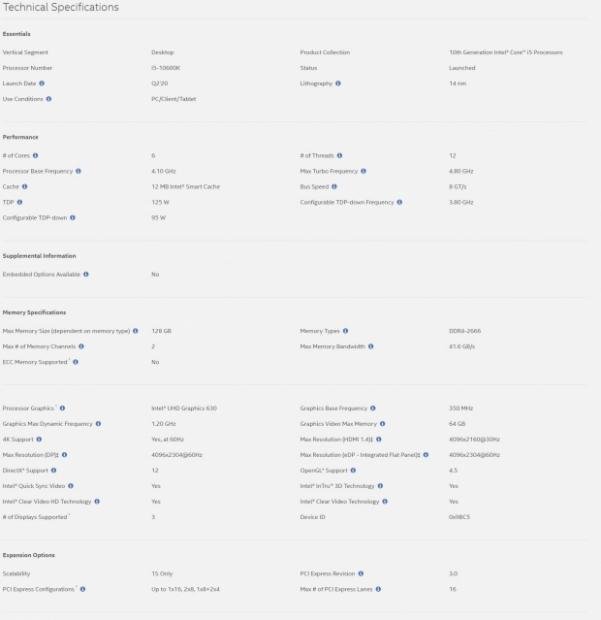
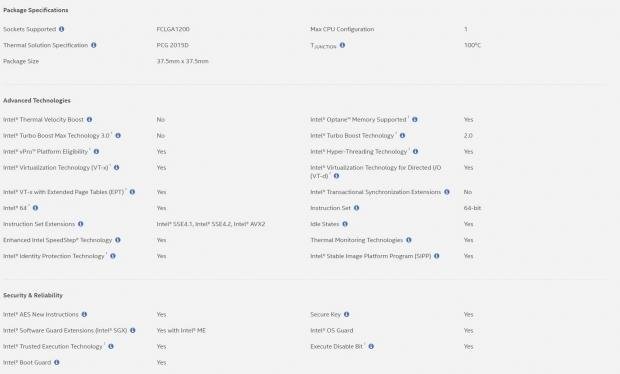
Next up is the Core i5 10600K, which is a six-core, twelve thread part. The same 125W TDP is in place, but the Turbo boost 3.0 and TVB are absent here. The 10600K has a max boost of 4.8Ghz, with a base of 4.1GHz. The memory speed is kept at 2666MHz, once again arbitrary, but I do find it curious why Intel would not have upgraded the supported memory speed across the stack.
The PL1 is 125W, and PL2 is 182W with a tau of 56 seconds once again. The PCIe is gen 3, as you would expect.
Pricing
The Intel stated pricing from their documents is $488 for the 10900K and $262 for the 10600K. However, this is for 1K unit pricing, so the pricing we are tentatively using is based on a bit of extrapolation of data we have collected over subsequent launches in the past.
The 10900K will likely fall to a market price of $529, while the 10600K should be around $269. This may adjust as we observed on the 9900K launch, where it had a similar 1K price, but Amazon at launch time, adjusted the pricing to $529.
Next up, we will look at the Intel marketing slides and then follow through some performance testing to show what these new CPU offerings have to offer compared to previous-gen and Ryzen offerings.

CPU, New Tech, Packaging, and Test Setup
Packaging
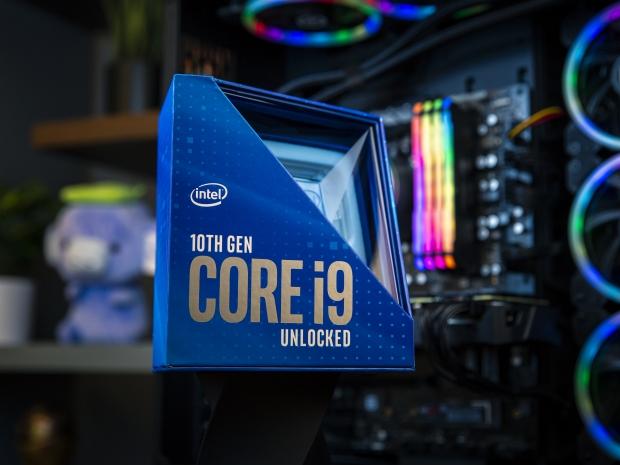
Here is what the retail package looks like, and I was hoping that Intel would send one of these over so we could show this unique packaging.
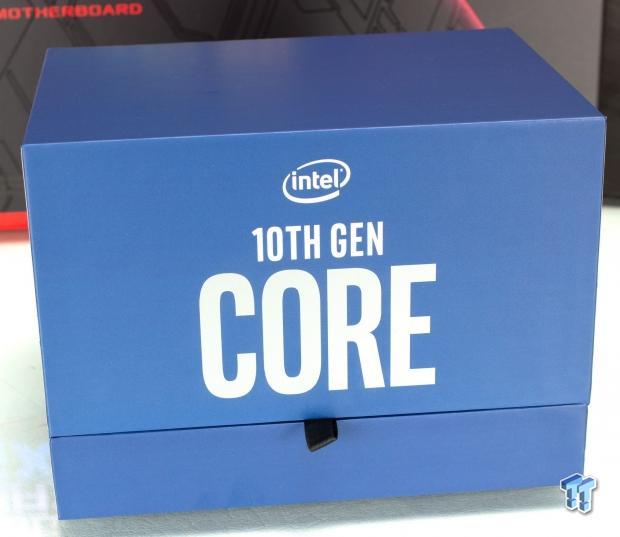
This is the package we received from Intel, along with an ASUS Maximus XII Extreme motherboard.
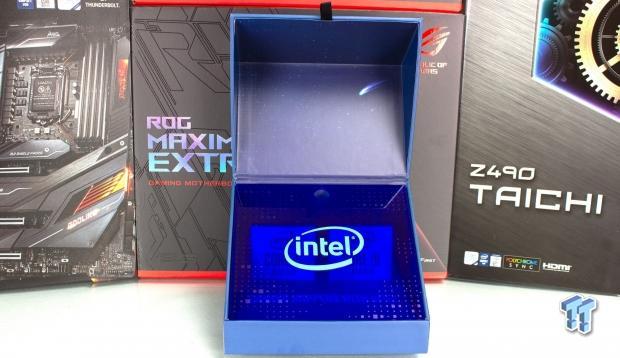
Opening the box exposes a space scene with, of course, a comet with full tail in view on the inner lid. I will say as far as wordplay applied visually; the pun is real. The CPUs are covered by a blue plastic or acrylic plate which covers the two CPUs.

Pulling the blue plate, we now find the two small CPU packages.
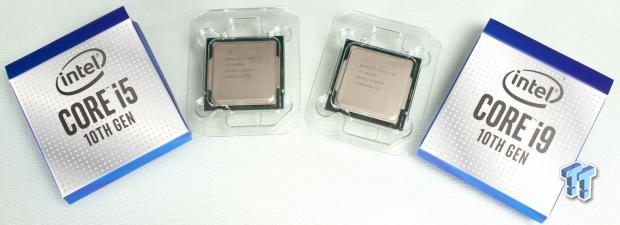
Now we have the CPUs out of the package, and we see we have the two clamshells which hold the CPU inside.
Intel Marketing Points
Here we give space to the manufacturer to talk about their marketing points, and we assess them and provide our point of view on the claims.
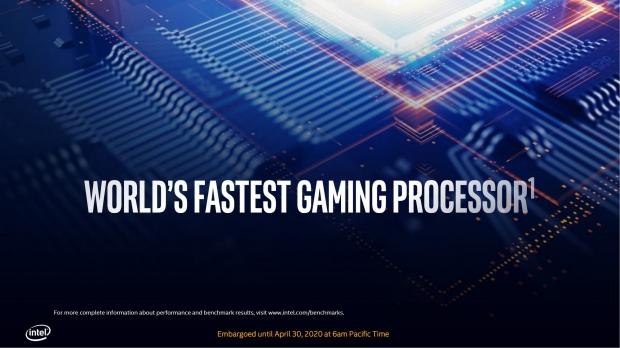
Intel has been touting the "fastest gaming processor" moniker for a fair bit now, or at least since Ryzen 3000 launched. This is due based on assumption and market conditions that Intel knew that Ryzen was fiercely competitive, but they still had a lead in gaming. This lead, however, has been nibbled away by Ryzen, so this is a sign that Intel knows it needs to act, so let's get to the next slides and see what they want to show off.
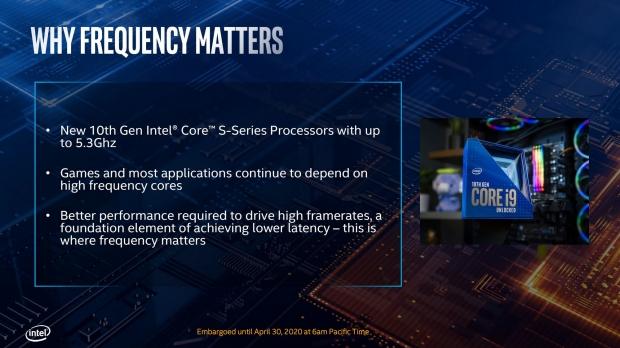
Here we have the explanation from Intel's point of view as to why frequency matters. These are some fair points, but one part omitted is that while frequency helps keep things moving more swiftly, the benefit of an optimized core at a slightly or in some cases a significantly slower optimized core can make up a lot of the proposed detriment.
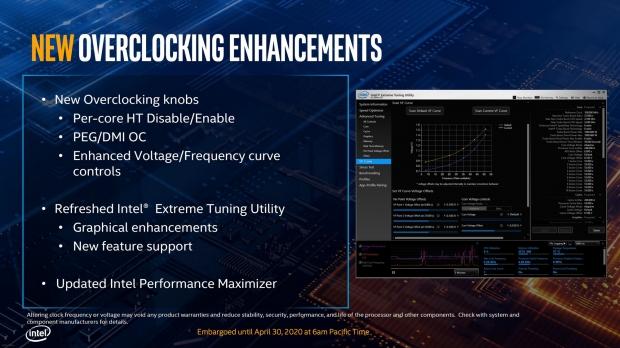
New OC enhancements are always something I welcome; however, showing XTU in this image hurts me in ways many cannot understand. I have a long history with XTU, and well, I will say its not the best app I have used by any means. However, let's not get lost in the weeds here.
The ability to adjust the VF curve is quite cool and beneficial for scaled overclocks. The ability to enable hyperthreading per core can be helpful if you have a weaker core that cannot clock well with HT enabled. It may give you better overall performance disabling the extra thread on that core. This should also appease the XOC crowd as some benchmarks have a hard thread limit, which can cause scores to be inhibited, and now you can scale the hyperthreading to match the benchmark capabilities.
Intel also is releasing an updated performance maximizer app that automatically assesses your system and tunes in an overclock for you based on the thermal, power, and boosting results it observes.
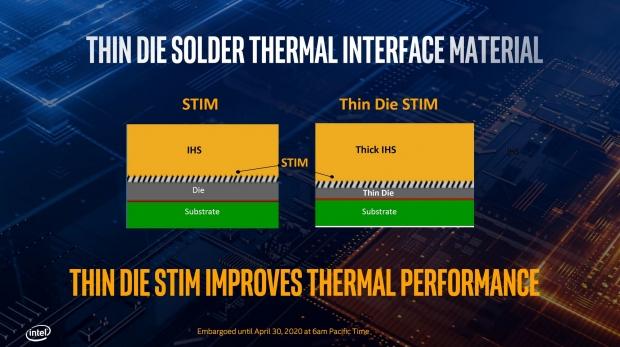
One point of contention for most of the community and myself included was that when Intel released the refresh chips, including the 9900K, we instantly noticed it was hot. Hot running is fine as long as kept within spec, but it did limit the vertical headroom to just above the boost clock for most users, even on liquid cooling.
Intel stepped things up a bit, as they have physically thinned the die, likely by reducing the diffusion barrier's thickness. This pays dividends as silicon is not the best for thermal transfer, and therefore less of it to go through should result in better temps. This is likely how Intel was able to squeeze more clock speed from these new chips. This also explains why the new TVB, which originated in notebooks, is used for its highest boost clock as it relies heavily on thermals to achieve the clock.
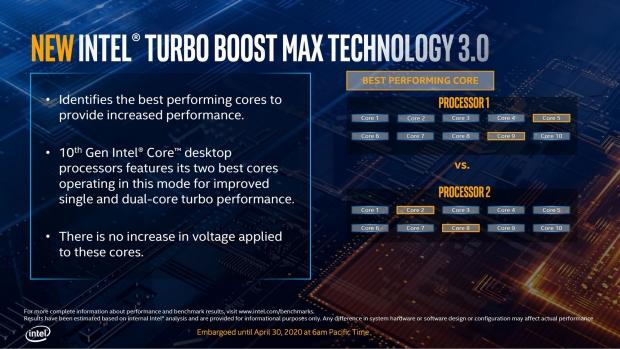
Here we see the inclusion of Turbo boost max 3.0, which is something we saw introduced on the X299 platform but now makes it to Z490, well sort of. The only CPUs on Z490 supporting the Turbo boost 3.0 are the i9 and i7 variants, while the i5, i3, and lower models get only the turbo boost 2.0 tech.
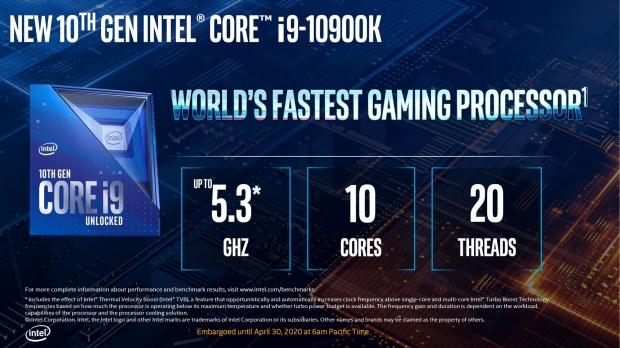
Intel's claims on this one are pretty accurate with their halo chip likely increasing the lead the 9900K had in gaming. However, it is a big grain of salt or a block at this point to continue to claim this without at least admitting that once you get up to resolutions, many gamers are now migrating towards, that lead diminishes. This is since to test CPU influence on a game, we usually run at a lower resolution and detail setting to take the load from the GPU and create a CPU bottleneck.
We do this as well; however, we also include the same detail setting at higher resolutions to provide an accurate picture to gamers who may look at CPU options and want to know how they may play at their chosen resolution.
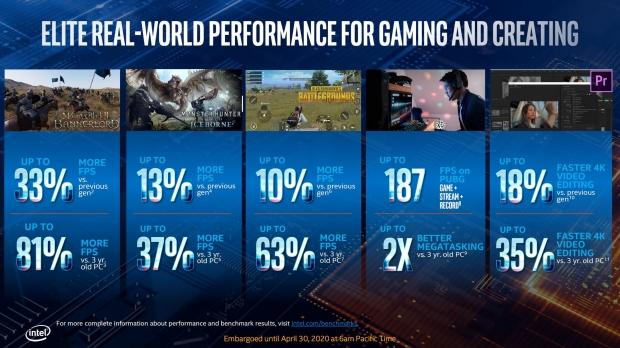
This slide I am adding more as informational or FYI data. This is Intel comparing their newest chips to both last-gen (9900K) and a 3 yr. old PC (7700K) is quite an appropriate comparison as the 7700K is genuinely an iconic CPU, which still holds relevance today.
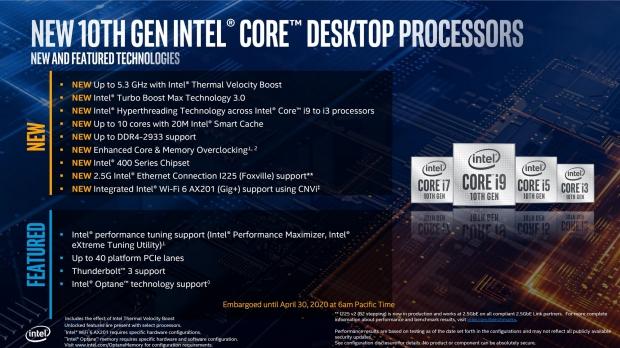
Here we get a summary of what the latest and greatest has to offer for users. There is a lot here; keep in mind that the CPUs are essentially a refreshing of the existing tech, so it will be another iterative step above the 9000 series we have now.
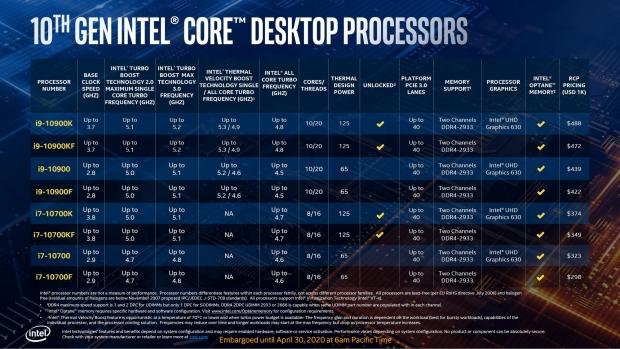
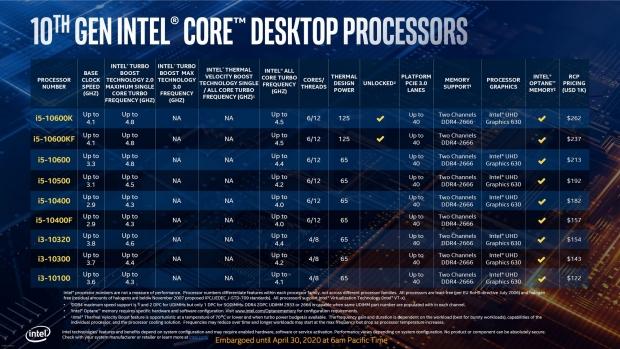


Here we have the entire stack of CPUs which are or will be available as you read this review. There are tons of models as most models on the upper end have a K model, a KF model which is unlocked sans iGPU, a non-K model which is not unlocked and a non-K, F model which is not unlocked and is sans iGPU.
Intel has roughly 32 models of CPU, including the low power T models. Therefore, it is safe to say that Intel has a CPU for pretty much any price point in this stack.
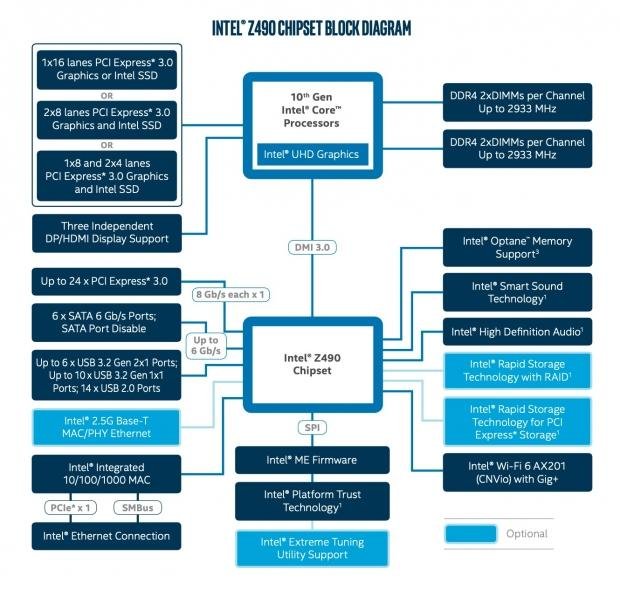
Lastly, before we get into our test system, we wanted to look at the block diagram for the new Z490 platform. The block diagram is very similar to Z390 but with the addition of 2.5G support added along with integrated CNVi support for Wi-Fi 6/AX.
I want to be clear here, it may come across as being overly critical, but there are benefits to a mature process and platform. However, being this is Intel, and we hold a certain standard and expectation for feature innovation. When there is a visible crack in the armor, it is the job of those who report on new tech such as I do to bring them up.
With a reasonably good understanding of what we are getting into, let us look at the test system used to benchmark both of these new 10th gen parts.
Test setup
My testbench is strictly controlled with a fresh OS for any platform or component change. The system uses all the same components whenever possible to maintain comparable results between platforms. The ambient in the test lab is rigorously controlled at 22C +/- 1C. All tests are run a minimum of three times, and any outliers are tossed, and another replacement test run will be completed to achieve our average results. The use of a TITAN RTX for the CPU testing ensures that the GPU is not the bottleneck for performance results and will best represent the scaling across CPU and platforms.
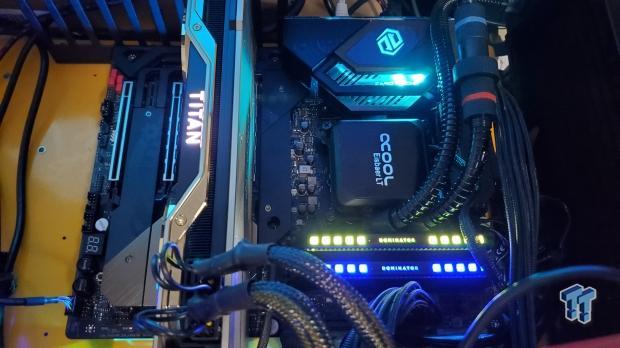
- Motherboard: ASRock Z490 Taichi (buy from Amazon)
- CPU: Intel Core i9 10900K & Core i5 10600K
- Thermal Interface: Arctic Cooling MX-4 Thermal Compound (buy from Amazon)
- Cooler: Alphacool Eisbaer LT 360mm (buy from Amazon)
- Memory: Corsair Dominator RGB 3600MHz 16GBx2 (buy from Amazon)
- Video Card: NVIDIA TITAN RTX (buy from Amazon)
- Storage - Boot Drive: Corsair MP600 (PCIe 4) 2TB (buy from Amazon)
- Testbench: DimasTech Easy XL (buy from Amazon)
- Power Supply: Thermaltake 1200W (buy from Amazon)
- OS: Microsoft Windows 10 (buy from Amazon)
- Monitor: ASUS XG438 43" 4K (buy from Amazon)
- Keyboard: Logitech G910 Orion Spectrum (buy from Amazon)
- Mouse: Corsair Logitech G502 (buy from Amazon)
WPrime, SuperPi, Cinebench, and AIDA64
WPrime
WPrime is first up and being a multi-threaded benchmark. We know it will scale with any CPU we throw at it. You can manually set the number of workers or threads you want to allocate to the calculation, which we did the total thread count for each CPU to ensure we measure the maximum performance the CPU can offer.
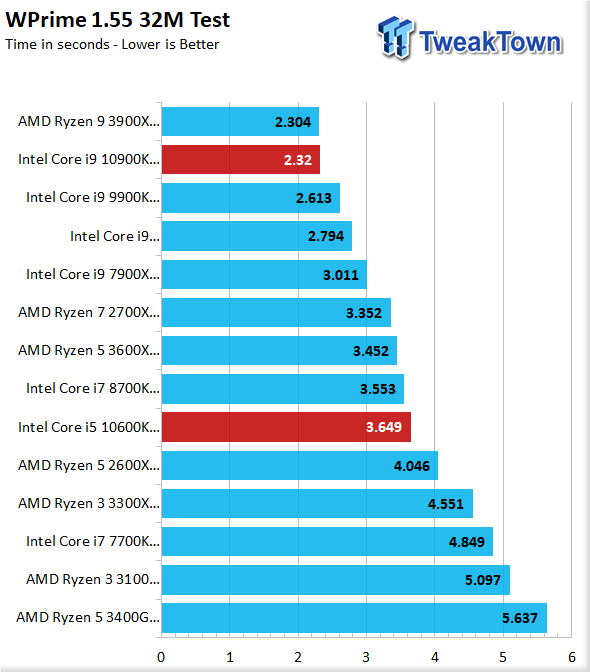
The 32M test is the shorter one and shows how each CPU performs with a quick burst multi-core loading. Here we see the 10900K fall right in line with the 3900X, which has a four-thread advantage over it, but that clock speed really helps it gain some ground here. The 10600K falls just behind the 8700K and 3600K, which is admittedly a bit surprising.
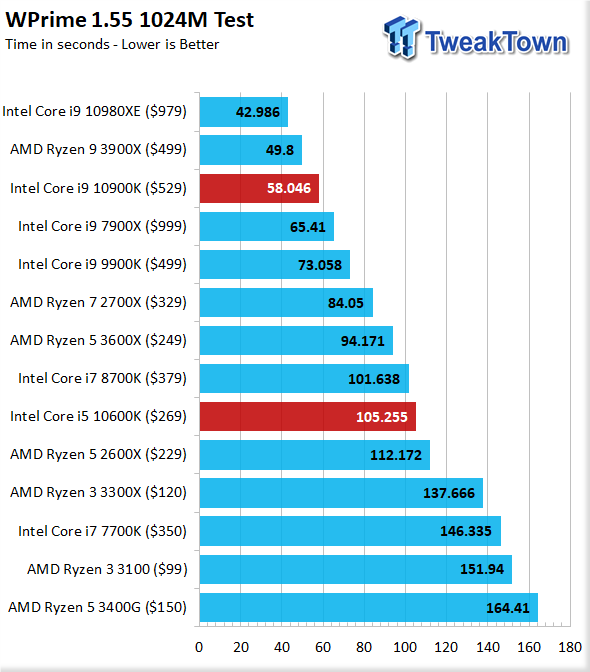
The 1024 test is the longer version and can take form as short as under half a minute up to several minutes depending on thread count and frequency of the CPU being tested. The longer 1024 test now shows the 10980XE jump ahead with its massive thread advantage. This is due to the time needed to start the workers, which hurts the 32M test.
Here we see the 10900K fall a bit more in line behind the 3900X, while also easily outpacing the 7900X HEDT 10-core. This is likely due to its frequency advantage. The 10600K falls right in line with the 8700K leading it, which once again is a surprise being that the 10600K has a 100MHz advantage on paper with the same amount of "intel smart cache."
SuperPi
SuperPi is a much older test, but it's worth including as it is a single-threaded computation workload that really can show in granular detail differences in the computational ability of the silicon being tested. One thing to note is that this aging application tends to favor intel architecture, so don't be surprised when you see much better results by some chips, like the same chips you will see get beaten in other tests.
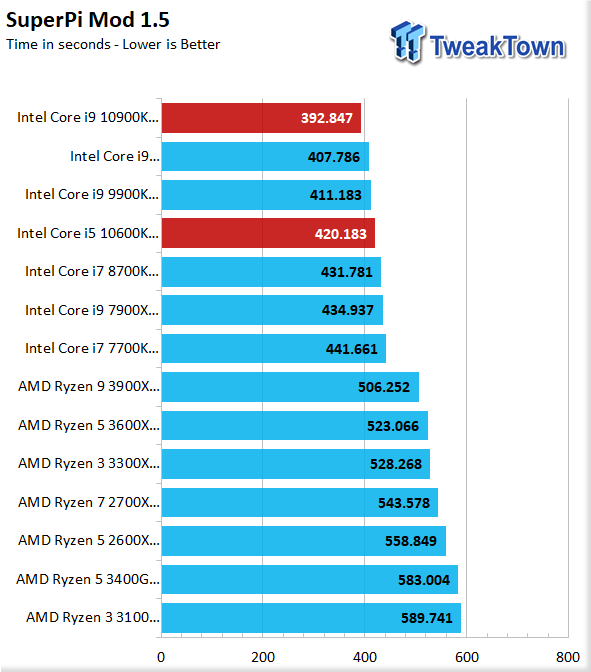
SuperPi shows the 10600K now take a jump over the 8700K and trails the faster 9900K and 10980XE, while the 10900K tops the chart here. That 5.3GHz TVB is showing a defined gain here.
Cinebench
Cinebench is a long-standing render benchmark that has been heavily relied upon by both Intel and AMD to showcase their newest platforms during unveils. The benchmark has two tests, a single-core workload that will utilize one thread or 1T. There is also a multi-threaded test which uses all threads or nT of a tested CPU
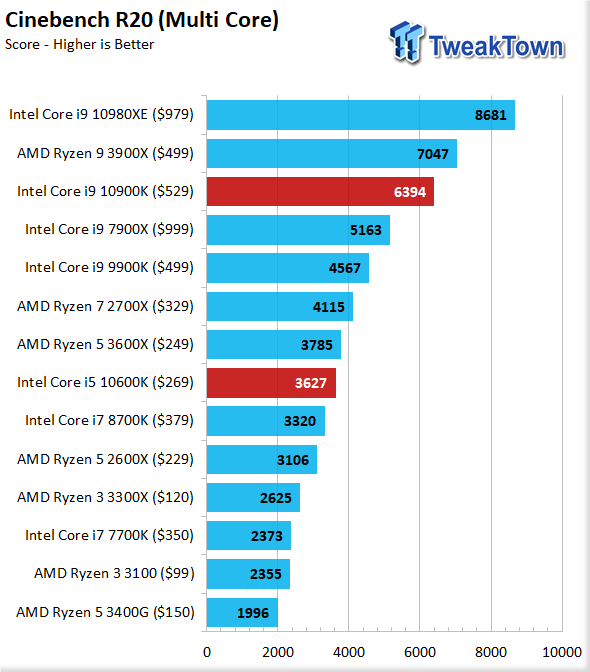
Here we see the 10900K fall a bit behind the 3900X, while the 10600K falls a bit behind the 3600X. Overall since Cinebench is heavily threaded, the nT result is showing how we would expect it to.
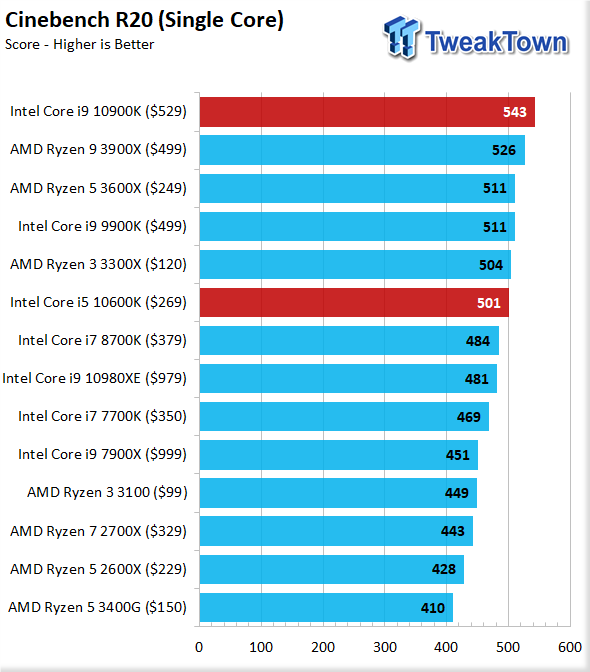
Moving to the 1T Cinebench test and we see that the 10900K easily tops the chart. The 3900X, 3600X, and 9900K round out the trailing pack. The 10600K falls to the 3300X and the others, which trailed the pack following the new 10900K. The 10600K easily outpaces the 8700K, which is now showing the improvements we expected from the CPU.
Aida64
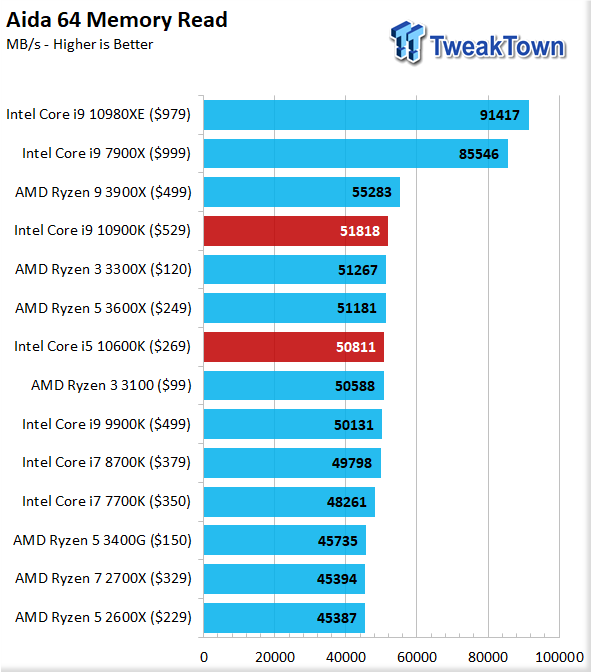
Aida's memory read test shows that the new 10th gen CPUs picked up a bit of throughput with the memory with the same kit. The Ryzen offerings show strong here with the 3900X pulling a convincing 55GB/s over the 10900k 51GB/s. the 10600K pulls 50.8GB/s, which is a marked gain over the previous-gen parts or the comparable 8700K at 49GB/s.
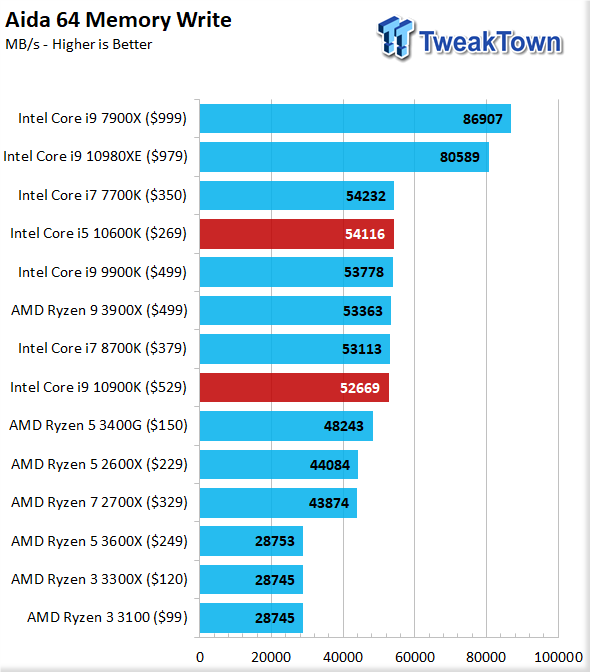
Memory write speed is where Intel jumps forward, passing all of the Ryzen parts slightly to 54GB/s for the 10600K. The leading 3900X from the read test shows a close lead at over 53GB/s, while the 8700K jumps past the 10900K at 53GB/s while the 10900K terminates at 52.6GB/s.
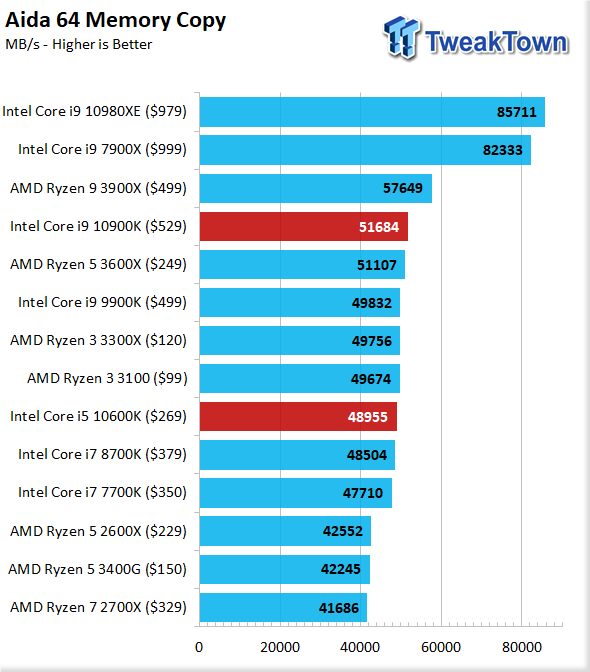
Memory copy results shuffle again with the mainstream platform results being led by the Ryzen 3900X at 57GB/s. the 10900K once again shows a trailing position here at 51GB/s. The 10600K falls just below 49, hitting 48.9GB/s.
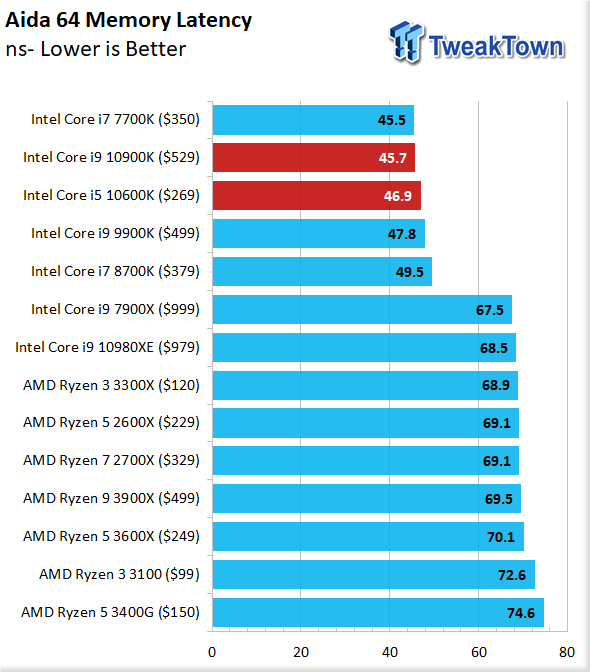
Now we have the latency test, which shows the memory, as expected, have exceptionally low latency (45.7 and 46.9 respectively) for the mainstream intel platforms. The Ryzen parts fall into the HEDT parts category exceeding 60ns.
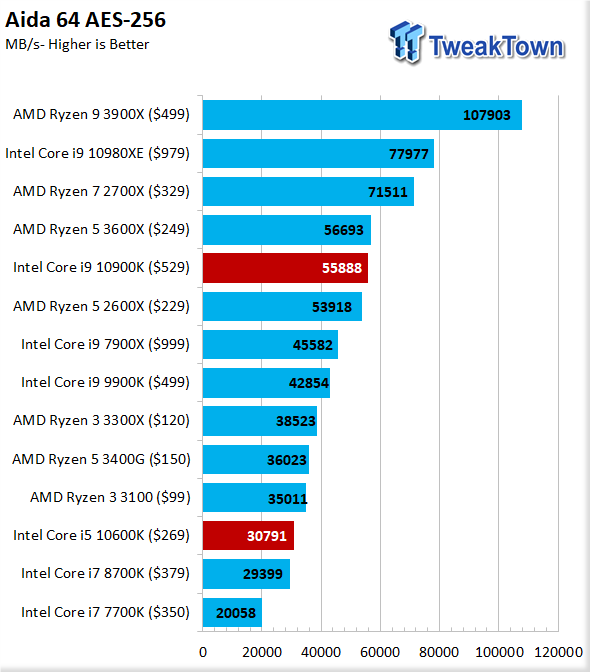
AES encryption performance we will see a massive shuffle as Ryzen has shown notoriously robust performance in these types of workloads. We see the 10900K pull a nice gain over the outgoing 9900K; however, it falters to the 3600X. The 10600K falls to the Ryzen 3100, while still outpacing the 8700K.
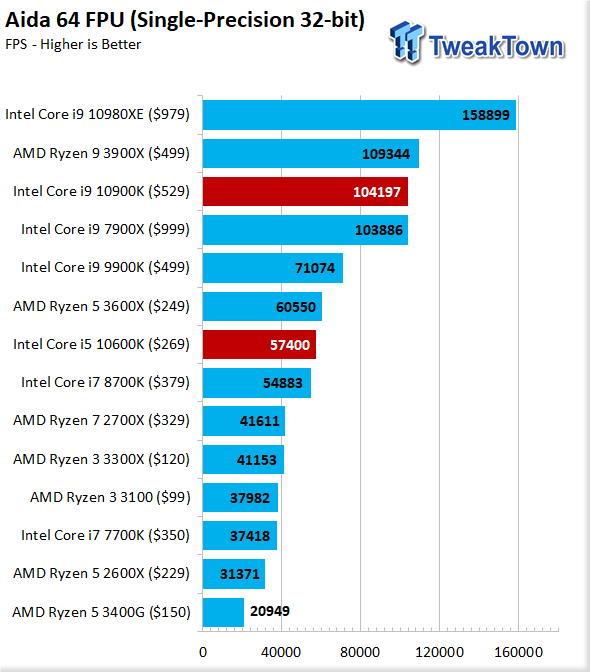
For FPU testing, we have 32-bit single-precision first. Here we see the mainstream platform leader in the 3900X with the 10900K trailing closely behind. The 10600K takes its position between the 8700K below it and the 3600X, which outpaces it.
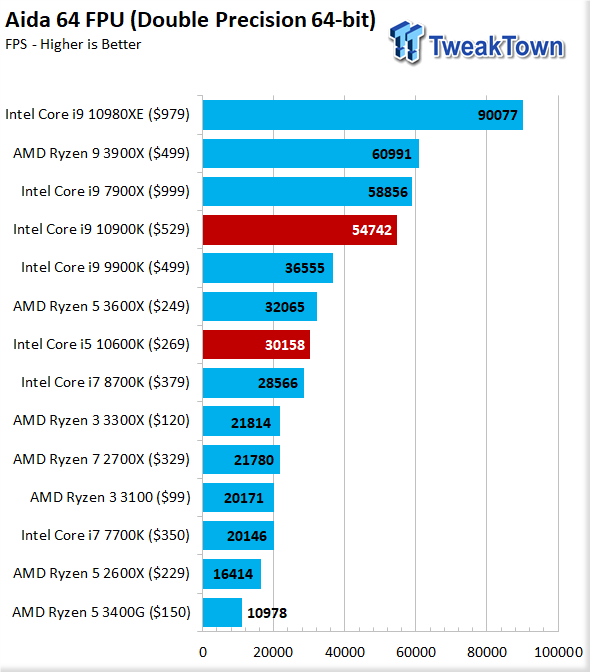
Now with the next level, we have the 64-bit double-precision test. This time, 7900X jumped ahead of the 10900K while the 3900X still carries the top end for the mainstream. The 10600K still sits in between the 8700K below it and the 3600X above.
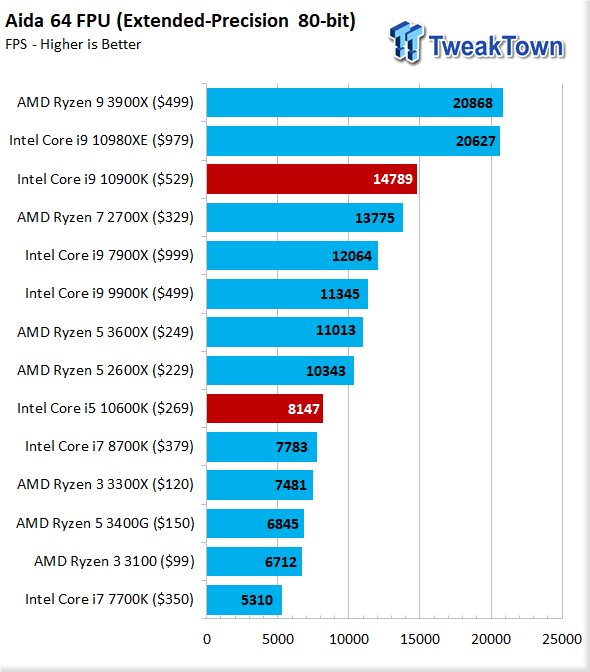
Lastly, we have an 80-bit extended precision, and here we see the same positioning as the previous test for our 10900K. The 10600K, however, falls a bit now, losing some ground to the 3600X and even the previous-gen 2600X. Of note here would be the 3300X, which is now nipping at the heels of the 8700K.
Handbrake, Blender, POV-Ray, CoronaRender, 7-Zip, and WebXPRT
Handbrake
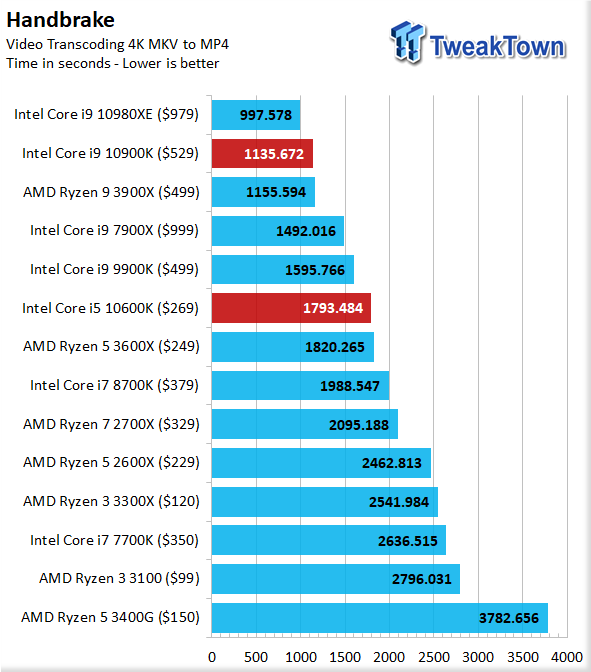
Handbrake is up next, and we are transcoding a 4K MKV to MP4. The 10900K takes its spot right behind the 10980XE and slightly ahead of the 3900X. The 10600K pulls ahead of the 3600X here, opening up a little space for it to stretch its legs and gain a little ground on the 9900K.
Blender
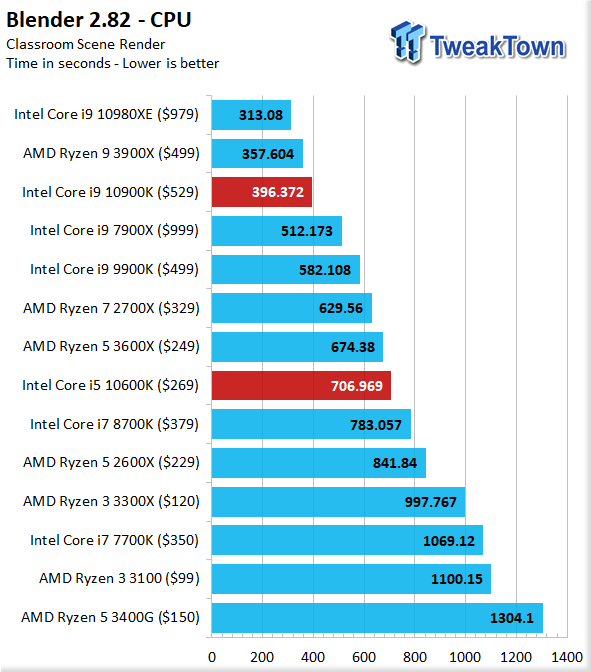
Blender shows once again the 3900X taking a spot ahead of the 10900K, while the 7900X falls far behind due to its much more limited clock speed. The 10600K shows more of the same with it slotting right in between the 3600X ahead of it and the 8700K trailing it.
POV-Ray
POV-Ray or Persistence of View Raytracer allows users to create 3D graphics. We use it to test both 1T and nT performance of CPUs as it renders out as fixed workload.
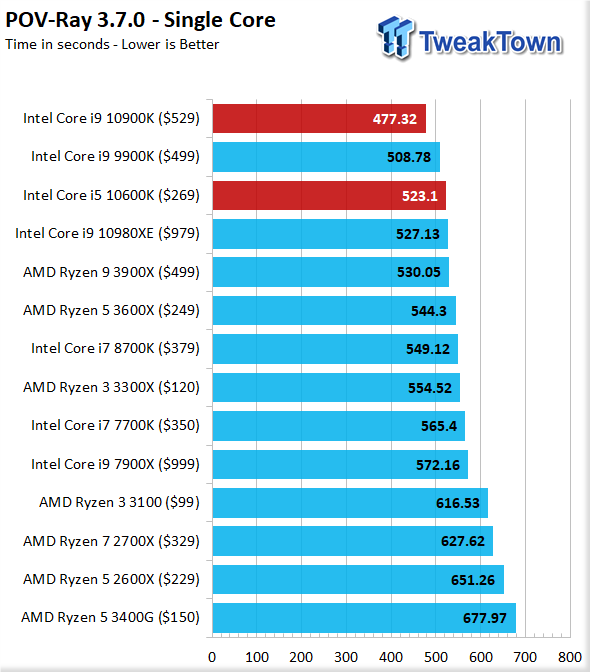
Here we see the duo of the 10th gen parts taking top spots in the 1T test. The 9900K falls right in between them with the 10980XE trailing. This is one of the first times we have seen both of the 10th gen CPUs take a spot above the 3900X from the Ryzen team.
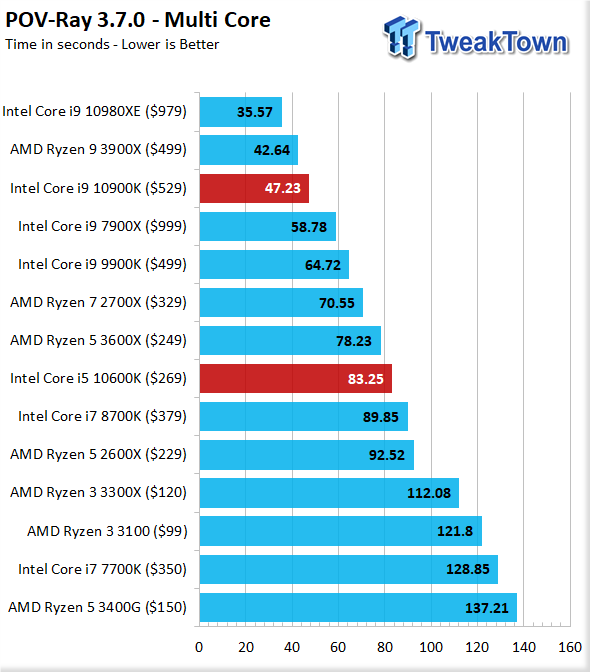
Expanding to the nT test, and we quickly see things reshuffle to the status quo. The 3900X steps ahead of the 10900K, while the 10600K shows more of the same as it falls in between the 3600X and the 8700K.
Cororna Render
Corona Render is a photorealistic renderer that can be integrated into several popular 3D modeling applications. It can also be used as a standalone application, which is what we opted for to best control variables.
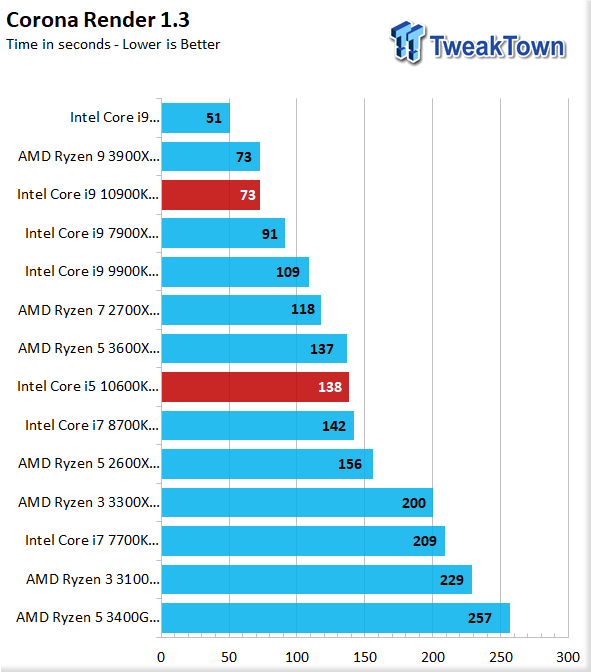
Corona Render gives us a more competitive result for the new 10th gen chips. Here we see the 10900K match the 3900X, while the 10600K is breathing down the neck of the 3600X, which has had a solid lead over the 10600K for most of the tests thus far.
7-Zip
7-Zip is an open-source and free compression application. IT works well with multi-threading and also can see gains from clock speed as well.
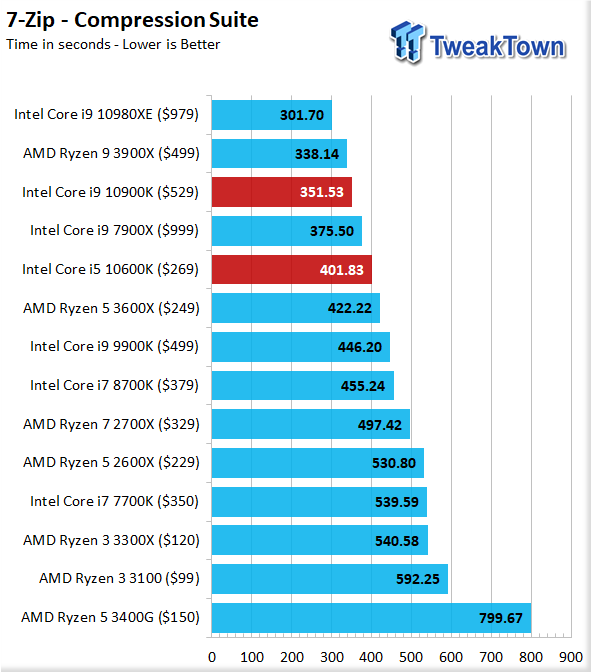
Here with the compression suite, we see that the flagship 109000K has a similar showing or more of the same. The 10600K, however, once again pulls a win here, bypassing the 3600X and even the 9900K for an excellent result.
WebXPRT
WebXPRT is a browser-based test, and we like this test as this is one of the areas not many think to test. This also happens to be a real-world usage test that can be impacted by the mitigations which have recently rolled through and were patched.
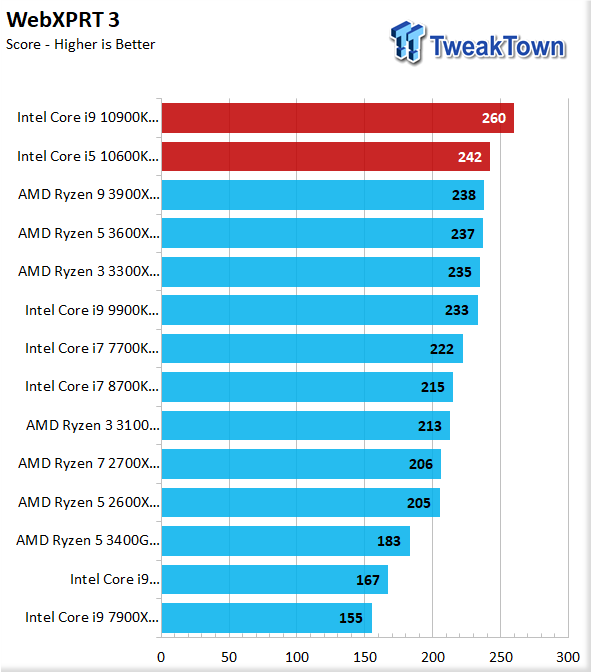
WebXPRT shows us the two new 10th gen chips topping the charts, as the 10900K pulls well ahead of every other platform tested, while the 10600K takes a spot almost 18 points behind the 10900K. This is still good enough for the 10600K to outpace the 3900X and every other CPU tested.
Unigine and UL Benchmarks
Unigine Superposition
Superposition from Unigine is a DX12 based benchmark. We test with the 720P LOW preset as this removes all but the most basic GPU loading, and all of the FPS performance comes from the CPUs ability to push frames to the GPU. This test is far more efficient and speed based rather than being highly threaded.
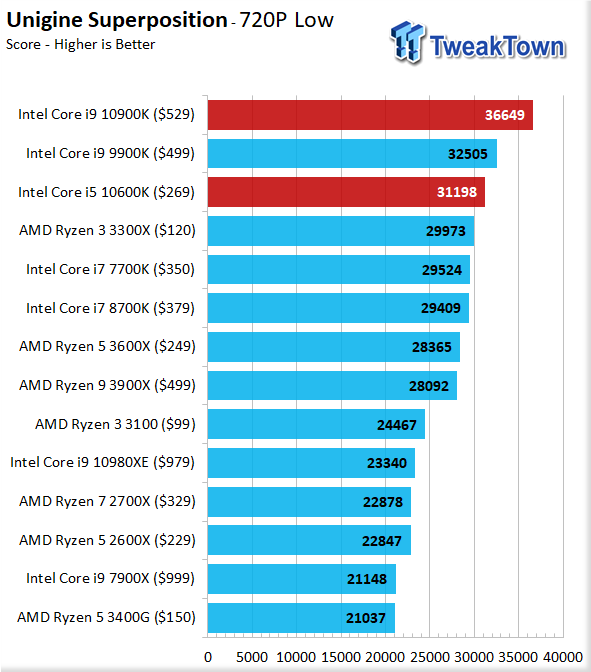
The 10900K takes a leadership position here, outpacing the 9900K by a sizeable margin. The 10600K does its own climbing of the ranks as it nearly catches the 9900K. This is a synthetic gaming style load, and Intel may be on to something saying they are still offering the fastest gaming processor.
PCMark 10
PCMark is a benchmark from UL and tests various workload types to represent typical workloads for a PC. Everything from video conferencing, image import, and editing, along with 3D rendering, are tested.
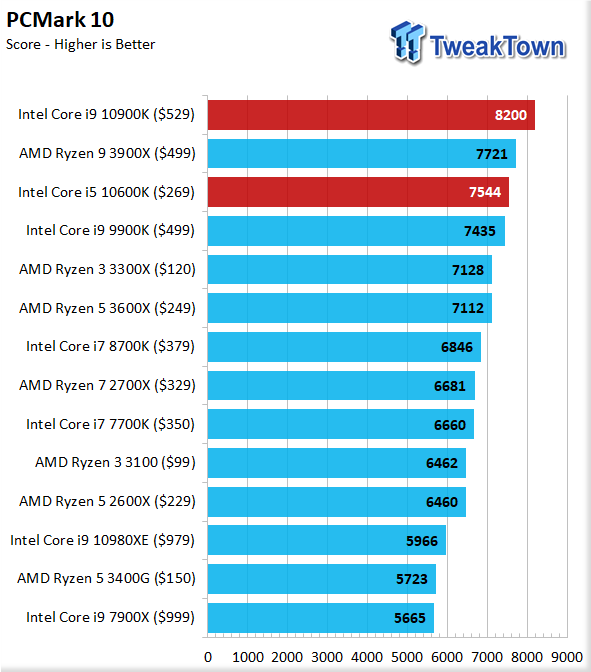
The overall score shows the 10900K leading the pack and the 3900X by almost 500 points. The 10600K trails the 3900X by only less than 200 points. The 9900K is closely trailing the 10600K, while the rest of the pack falls off from there.
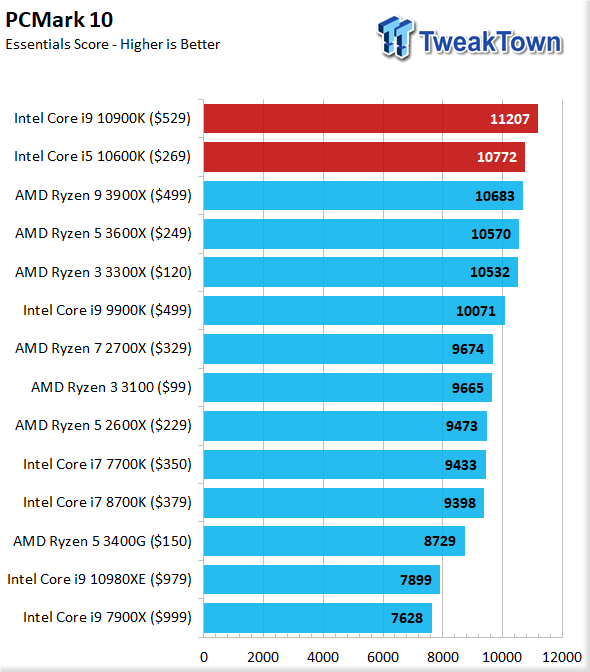
Essentials testing shows the two new chips topping the charts with the 3900X once again in a close trailing position behind the 10600K.
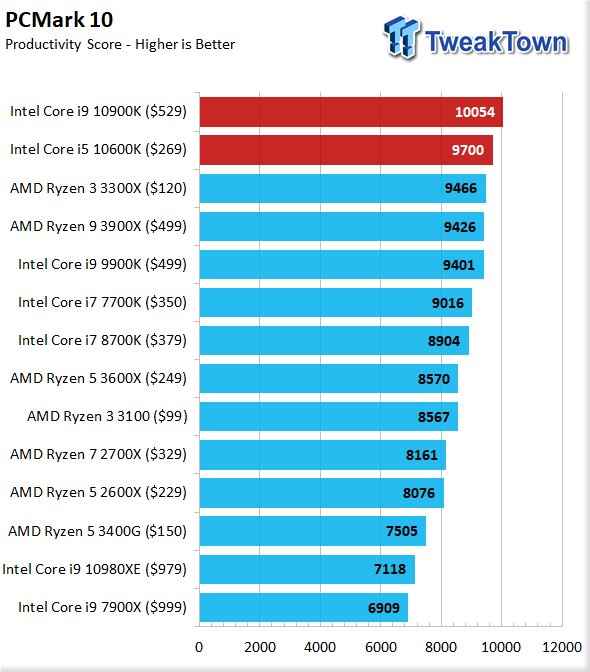
Productivity shows more of the same, but this time, we see the 3300X jump to the trailing position behind the 10600K.
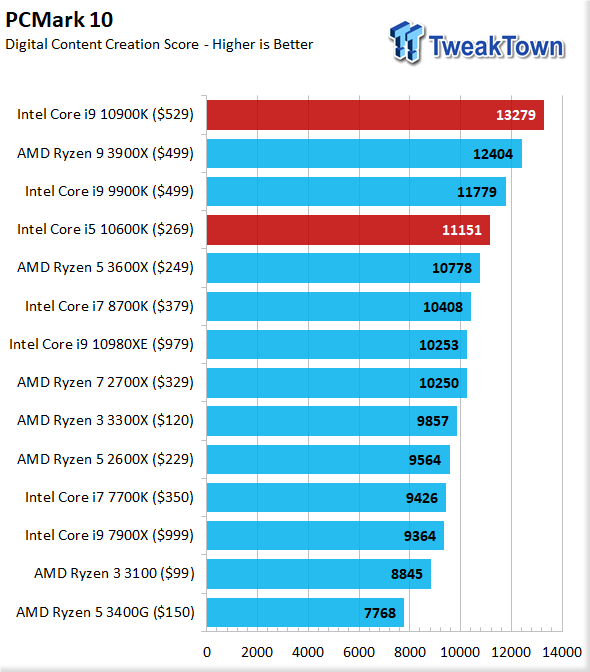
The digital content creation is the great equalizer as we see that multi-core jumps back into relevance, at least somewhat. Frequency is still particularly important, as we see the 10900K take a decent lead above the higher core count 3900X. The 10600K stays ahead of the 3600X and 8700K by a reasonable margin.
3DMark Firestrike
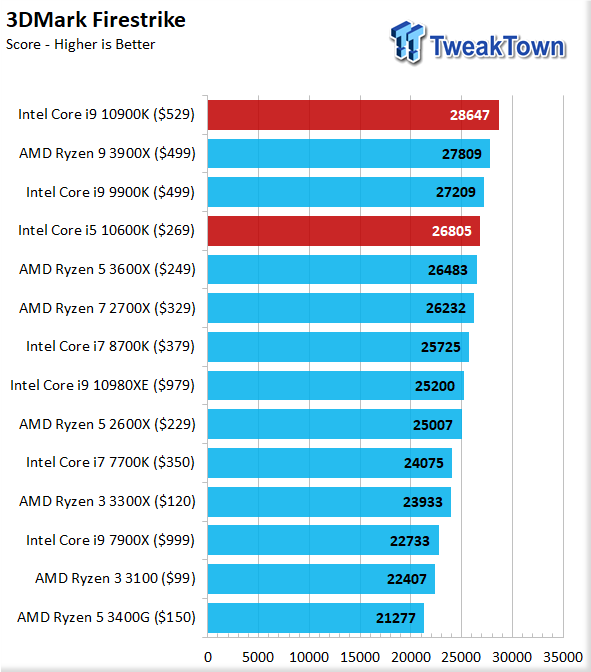
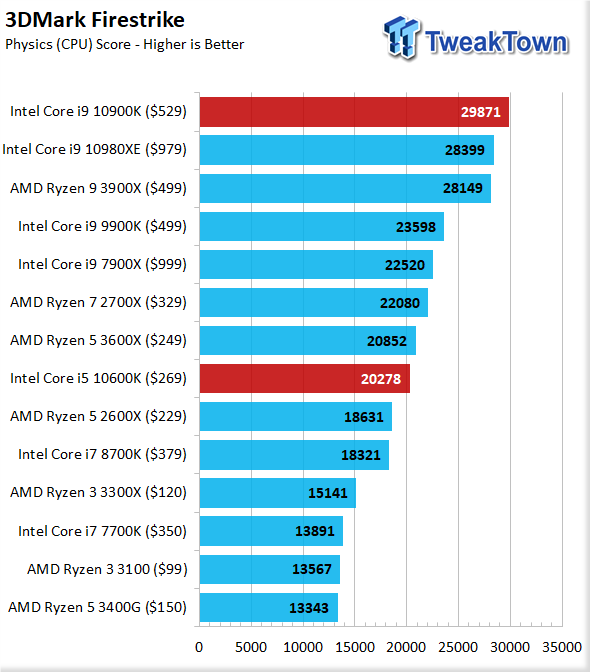
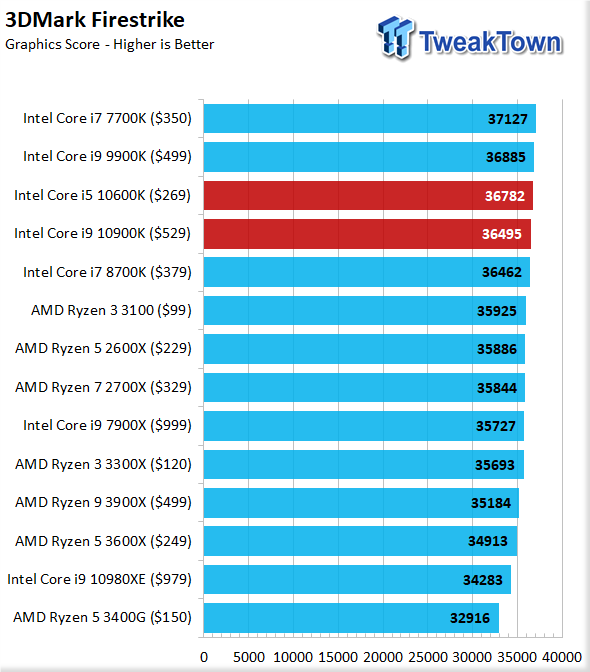
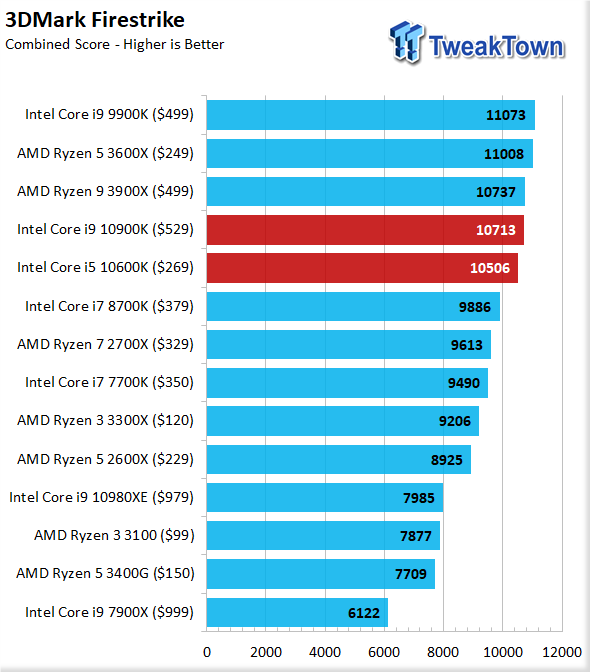
3DMark Firestrike shows the 20900K tasking a leading position in both the main score and the CPU score. The graphics score is nudged out surprisingly by the 9900K and the 7700K. This is an anomaly we observed in the Ryzen 3 review we completed recently.
The combined test also showed a reshuffle as the 9900K led the pack for best CPU and graphics performance when tested combined. And the 3600X and 3900X followed before you get to our two new entries. Overall the 10900K and 10600K score higher here, offering a clear view that 14nm at least under this test load is still quite viable.
3DMark Time Spy
Time Spy is another 3DMark test variant, but this one is for DX12 based systems. This test can be quite stressful, and since its an entirely different load, you may be surprised to see how the results shuffle when compared to Firestrike.
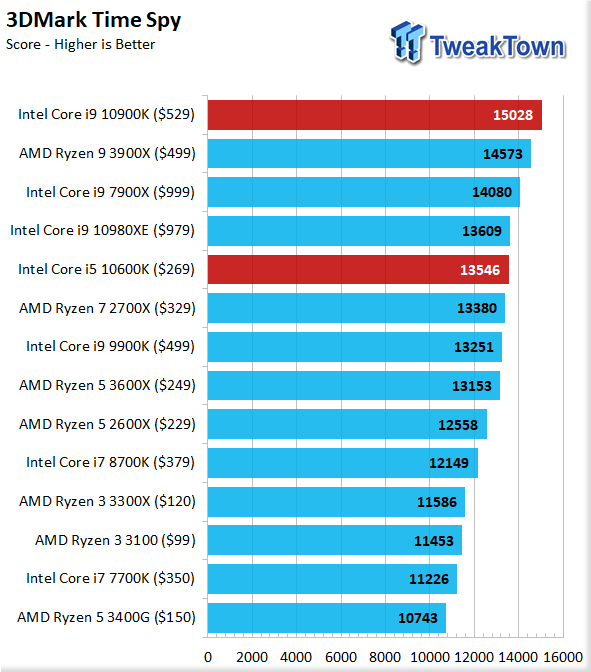
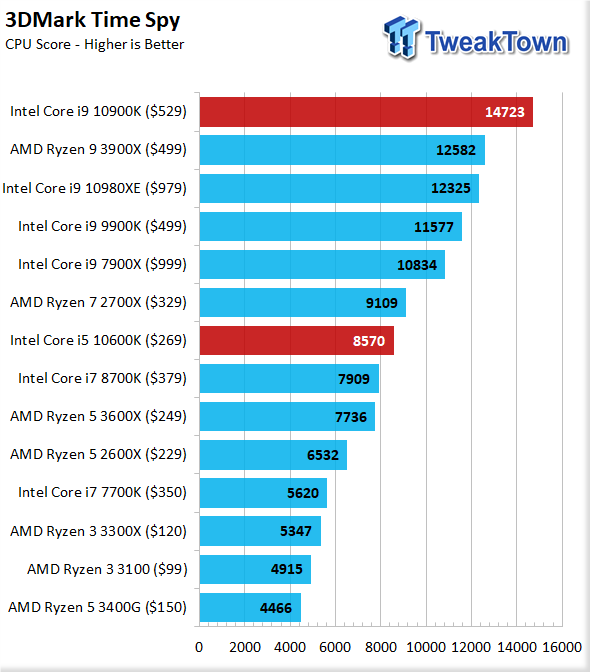
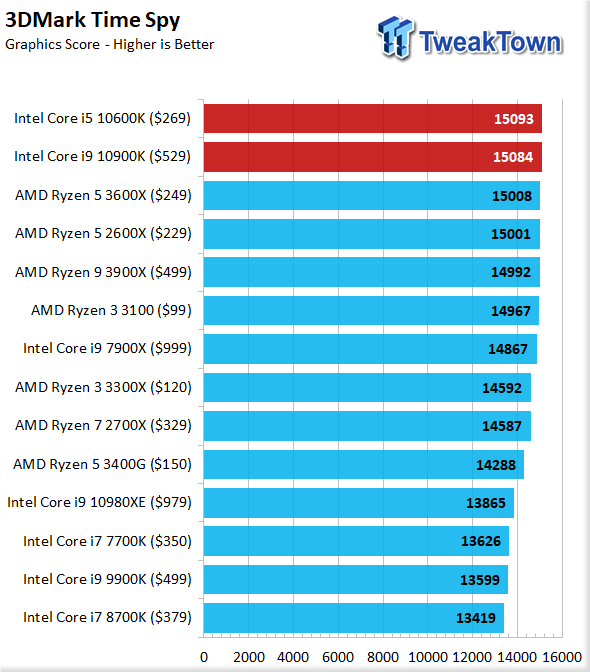
Time Spy is a newer benchmark utilizing a more modern API, which helps it cope with higher thread count CPUs and the capabilities of newer hardware. Now the main score shows a proper split where the 10900K still rules the roost followed closely by the 3900X. Then we have the 7900X and the 10980XE before we see the 10600K show its face.
Moving to the CPU result and it's more of the same, but now the 2700X jumps ahead of the 10600K, while the 8700K also jumps ahead of the 3600X. The 10900K has a notable lead over the 3900X in the CPU test, which tells us that the test likes frequency, and not just threading.
The graphics score shows the two new chips leading the pack once again as they both score in the 15K range, and the closest follower is the 3600X, which is a paltry 80 points behind the lead. We must note that the minimum score here is 13419 from the 8700K; that is why we scaled the chart from zero to ensure you can see how close these results are. This test demonstrates how hard the CPU can push data to the GPU to get frames pumping, and it is nice to see that the mainstream chips such as the 10600K and 3600X get some love here.
Gaming Benchmarks
In gaming tests, most testers tend to lower the resolution to 720P or 1080p, which works to show the CPU FPS, however, it's not very realistic for how a person would use a CPU in the real-world. We record 720P results in case they are ever needed, but we show 1080p as it is still one of the most popular resolutions. We also test 1440p and 4K, which some may question, and I will explain.
I want to show you who may be considering a purchase of these chips the actual difference you will see based on the resolution you may be gaming at. I believe this will open the minds of many to see that many CPUs can provide a great gaming experience sans 1-2 FPS if you are gaming at higher resolutions.
Shadow of the Tomb Raider
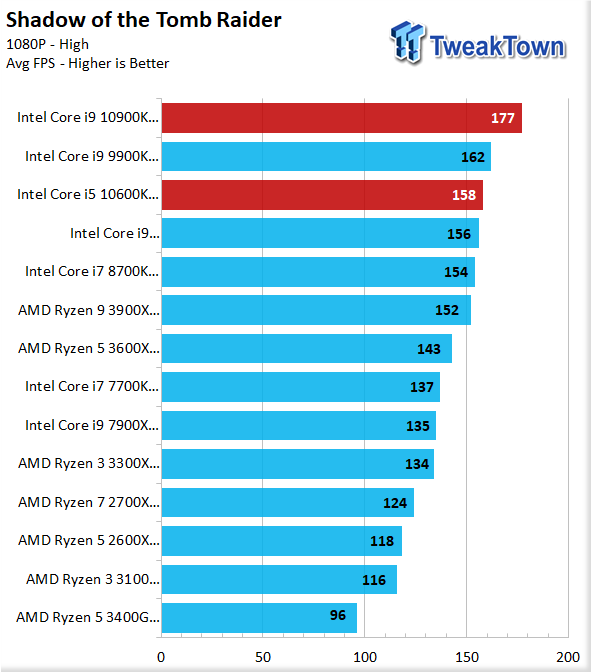
At 1080P, we see that Tomb Raider gives the new 10900K a defined lead, likely by its clock speed boost. The 9900K somewhat closely trails the 10900K as it loses by 15 FPS. The 10600K comes next and is closely trailed by the 10980XE. If you happen to be using a high-end GPU such as a 2080 or higher, this scaling will be what you will see on this title, if you play at 1080P.
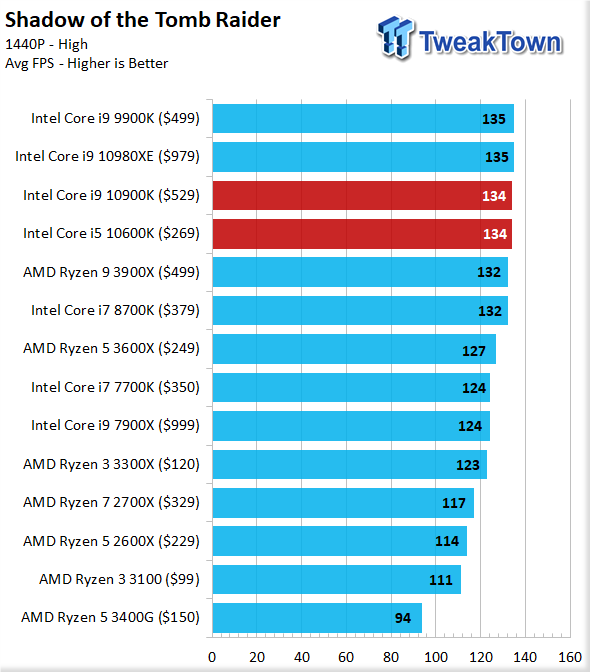
Moving to a popular enthusiast resolution 1440P, we see that the 9900K and 10980XE jump ahead now at 135FPS. Both new CPUs show 134FPS average over several runs averaged and therefore took the loss at a very slight margin. The 3900X and 8700K are close by averaging 132FPS, or two less than the new 10th gen parts.

We are moving to 4K, which is the new ultra-enthusiast's resolution range, and we see that the load has moved to the GPU now. All GPUs are stepping on each other's toes, with only the Ryzen 3400G falling off the pace.
Wolfenstein Youngblood
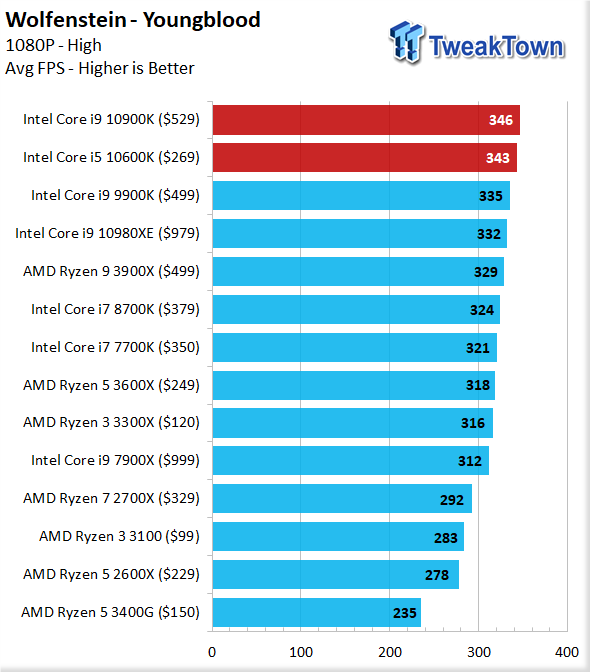
At 1080P, Wolfenstein shows the 10900K and 10600K leading the pack once again and by a noticeable margin. They are trailed by the 9900K and the 10980XE and then the 3900X. The rest fall part by part, slowly losing a few FPS along the way.
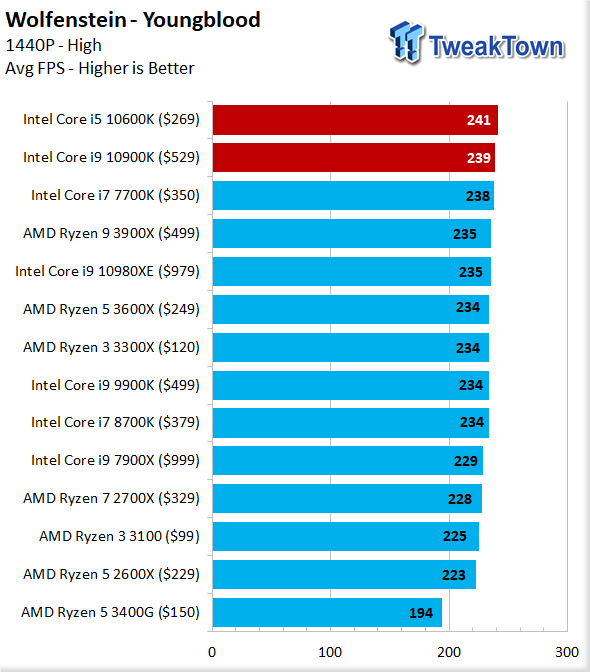
Shifting gears to 1440P and we see the field squeeze a bit with the two new chips taking the lead still. This time the 7700K trails them by a single FPS and the 3900X ticking off another three FPS behind the 7700K.
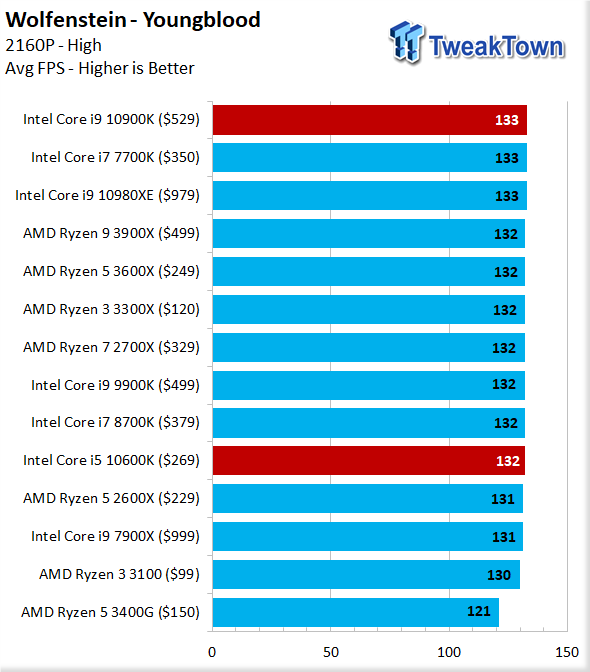
Turning the wick to full burn and we see the 4K performance once again being the equalizer. We see the 10900K sharing the top result with the 7700K and the 10980XE. Then we move down from 133 to 132 FPS, and we have a large portion of the remaining chips. Once again, the only chip to fall noticeably off the pace is the 3400G.
Civilization VI
Civilization is a quite popular game, and its performance we will test consists of standard graphical tests, which we will represent with average frame times for each resolution. We will also examine the AI turn time for each CPU to show how long each turn for AI will take based on your CPU performance and efficiency.
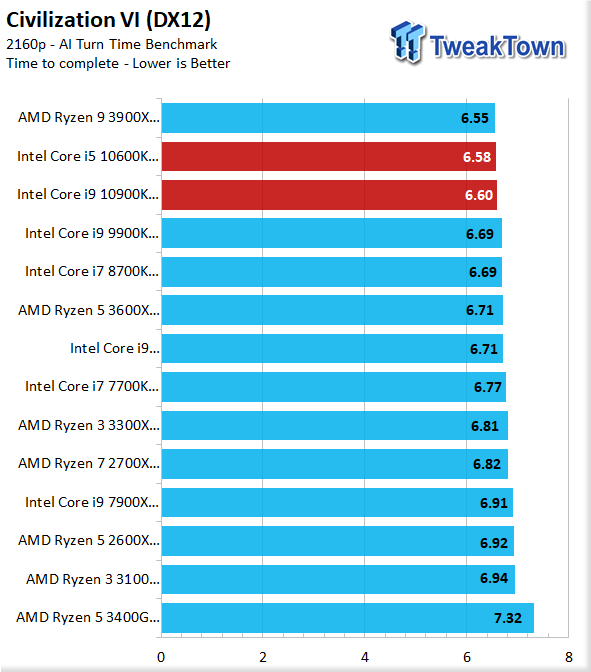
First up for the Civ VI testing is the AI turn time test. This shows the two new contenders falling just shy of the 3900X, but decently ahead of the 9900K. Then the 8700K and the rest fall in line behind this. This is the measure of how long it takes to process an AI turn in seconds, so keep that in mind as with multiple AI, it can add up over the entirety of the game. But, the difference here is not huge.
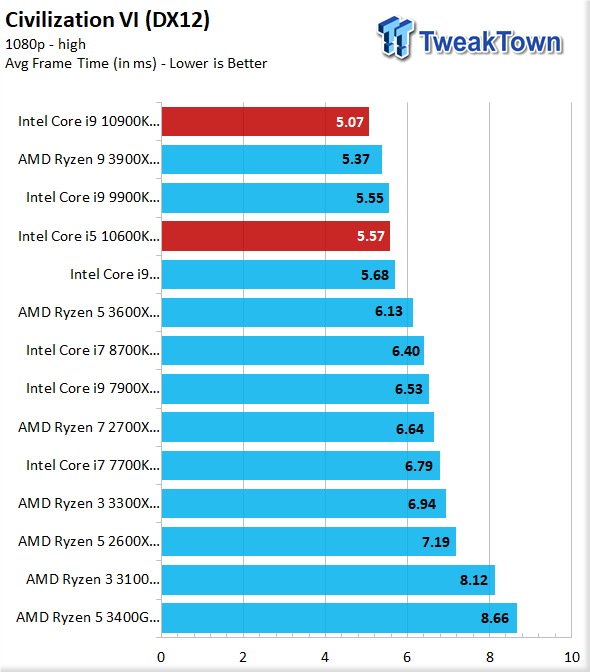
1080P once again places load primarily on the CPU to render, and we see the 10900K jump to the lead here with the 3900X being relatively close behind. The 9900K, however, is closer to the 3900X than the 3900x is to the top spot, and the 10600K is nibbling at both.
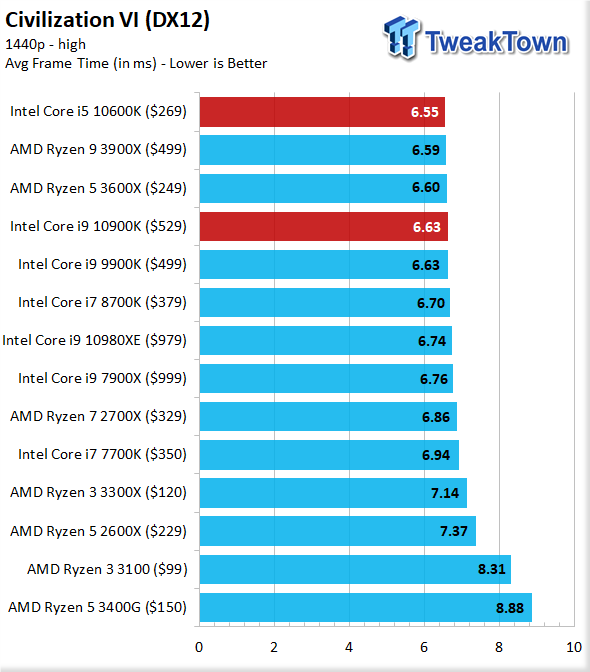
Moving to 1440P and we see the same positioning, except the 3600X, jumps up ahead of the 10600K, and the gape between the leading 10900K shrinks to almost stasis. The 9900K is tied with the 10600K, which is quite good, being the 10600K is roughly half the price or less.
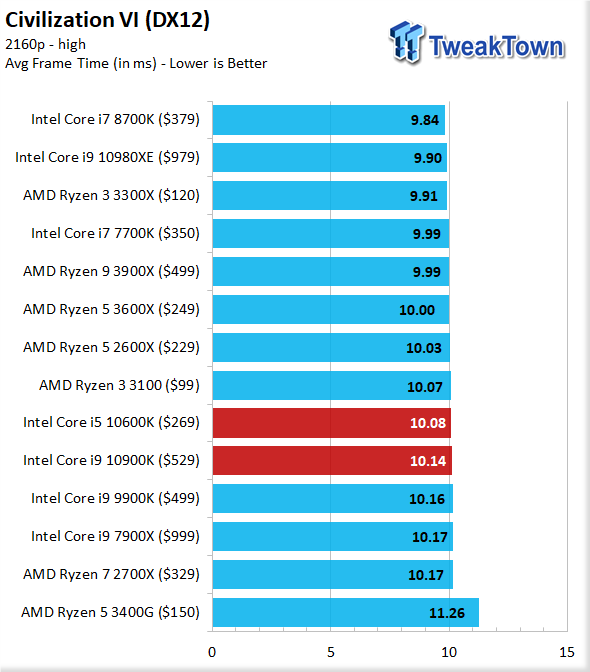
Once again, 4K levels everything out, and the top spot now belongs to the 8700K. The two 10th gen chips fall to lower-mid of the pack, which is not saying much as they are awfully close in relation with only the 3400G falling significantly off the pace once again. It is worth noting that while the results are tight, they are measurably different, but it's close enough that I would call most of them a wash with roughly similar results.
Storage Performance
CrystalDiskMark
For storage performance, we test the platform using a PCIe 4.0 Corsair MP600 2TB M.2 NVMe drive. It is tested in CrystaldiskMark 7.0.0 x64, and we average the results to ensure a good cross-section of expected performance. Do note that some platforms do not support the new PCIe gen 4, and therefore will cap out around 3400-3500MB/s.
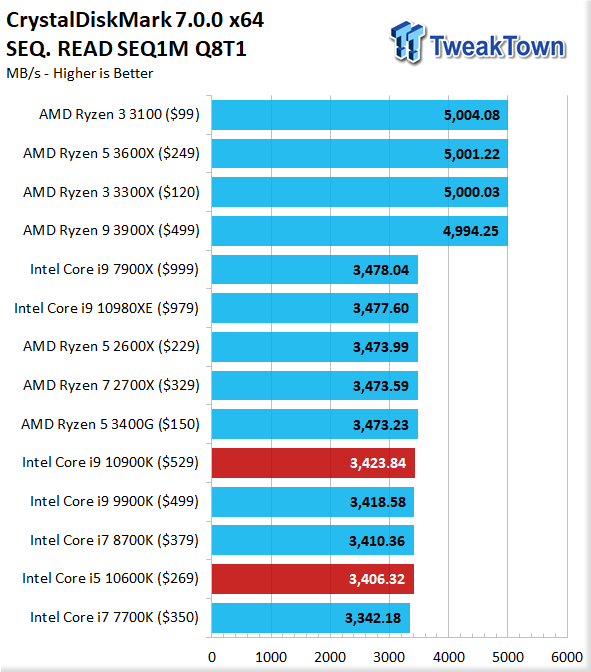
First up is the Sequential read test, which every manufacturer tout as the "up to" speed, but in reality, you never see this in everyday usage, but I digress. Here we see the new 10th gen chips fall roughly into the mix with the other Intel entries. These all are roughly comparable with only the 7700K and its older chipset falling off the pace.
The variance of these results can be explained, as in many cases, the application can run on a lower-speed core on a specific chip, which causes variance in the overall result depending upon where the "best core" happens to be.
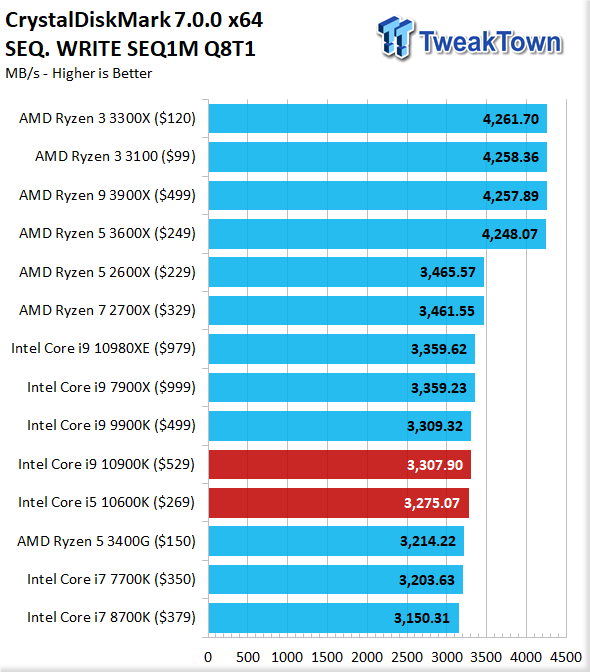
Here we see the sequential write result for our MP600, and this one seems to respond much more to the differences in a platform as we see scaling ranging from 3465MB/s to 3150MB/s or a span of over 300MB/s across the PCIe 3 equipped platforms.
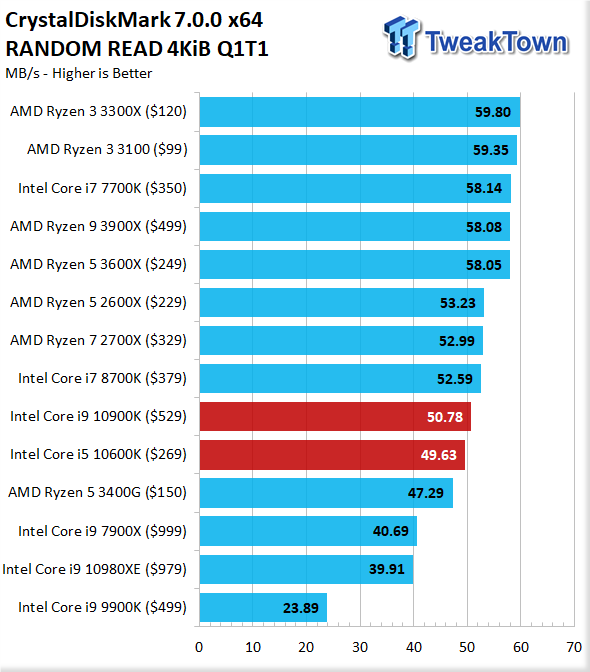
Next up is your random read, which is likely something you will experience more often in everyday computing. These are tiny files at a low queue depth. This is usually an area where OPTANE or a 3DXPoint storage solution rules, but the PCIe 4 drive does well here.
We once again see varying results with the new 10th gen parts falling into the middle of the PCIe 3 stack with the random read portion of the test.
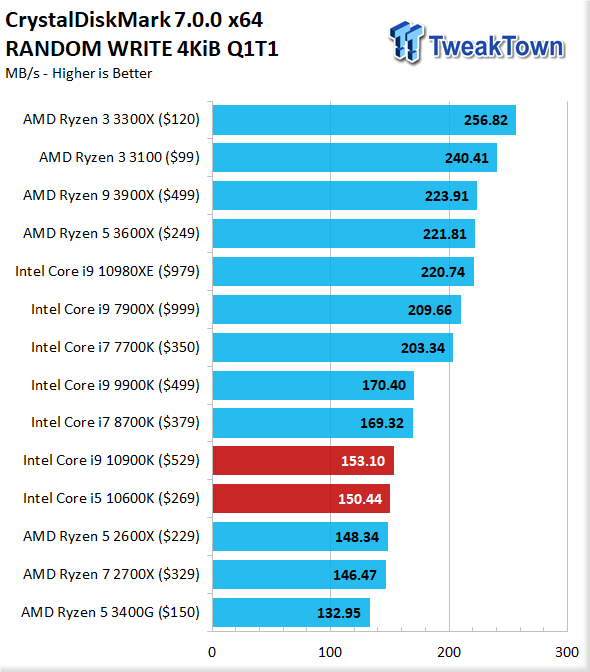
The MP600 tends to do much better here with random writes. The PCIe 3 platforms close up ranks a bit here, but 10th gen parts still find themselves mid-pack. Not bad results but not the best result either as only the Zen+ parts fall behind them.
Clocks, Overclocking, Thermals, and Power Consumption
Here we will look at the physical and functional performance metrics for the new Intel Comet Lake processors. This includes out of the box clocks, thermals, power consumption, and of course overclocking.
Out of the Box Clocks
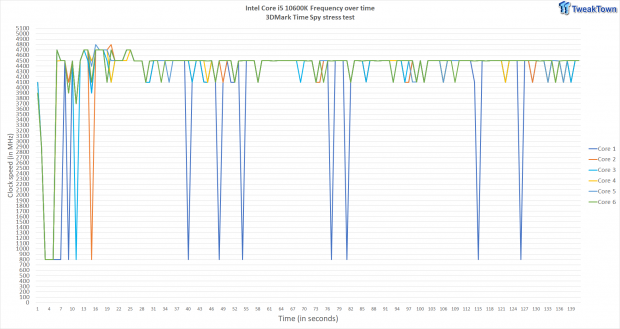
First up is a frequency plot for the Core i5 10600K. Here we see that the chip boosts up to 4.8GHz, as shown in its spec for short bursts. But overall, under the time spy stress test, it resides at 4.5Ghz with the occasional dip to idle core state during scene transitions.
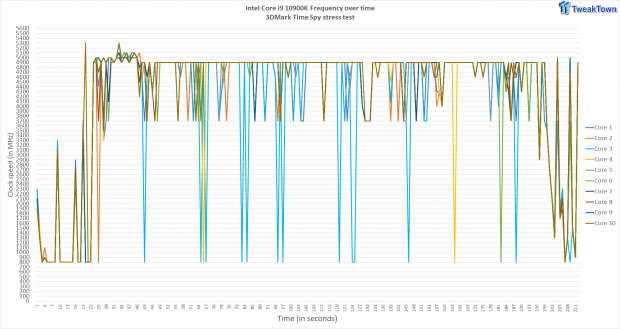
The 10900K is next, and we can see that the chip does indeed boost to 5.3GHz for small bursts, but most of the work is done at 4.9Ghz. The lighter loading scenarios you can see the CPU clock to the 4900 - 5300MHz range, which was during test setup and preparation to start the bench.
Power Consumption
For power consumption tests, we use a wall meter to test the full system draw. The reason for this is it will represent what the entire system pulls versus our meter, which shows power draw on each PSU cable. The reason for this is that measuring the power draw from the EPS cable, for example, does not take into account VRM losses and, therefore, can show a much higher power draw for the CPU or other device due to an inefficient VRM design or loading range.
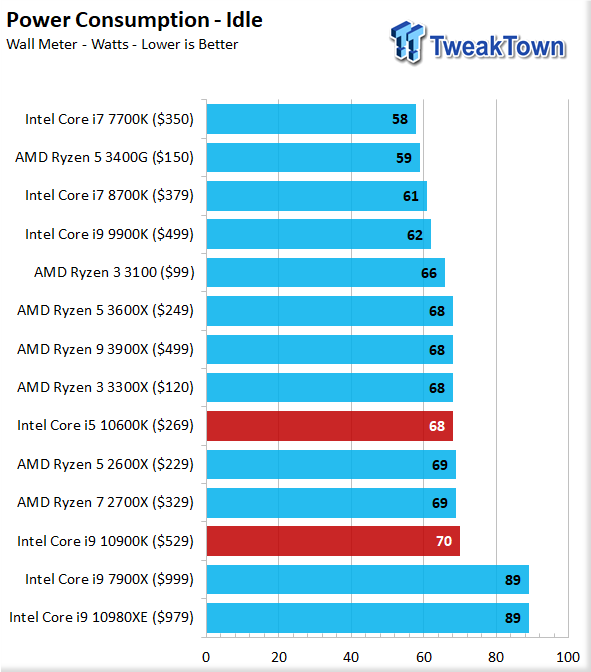
Idle power with the full system and TITAN RTX discrete GPU in place, we see the 10900K pulling 70W, which is the highest for our mainstream testing. The 10600K we see two watts lower at 68W, which matches several of the Zen 3 powered CPU entries.
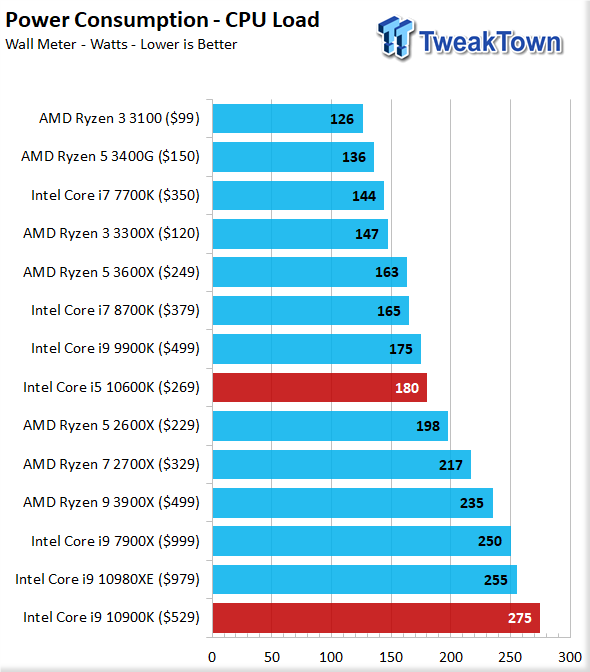
Loading up the CPU with a full CPU, FPU, Cache, and system memory loading, we see power jump to 275W loaded for the 10900K. This eclipses the lower clocked HEDT 10980XE and 7900X. It is also 40W over the Ryzen 3900X and a full 100W over the outgoing 9900K.
The 10600K finds itself at 180W, which is still 5W higher than the 9900K and 15W higher than the 8700K. For comparison's sake, the 3600X sits 17W under the 10600K, which is likely due to the power Intel is having to start pushing into these chips to get them to keep delivering at the same manufacturing node.
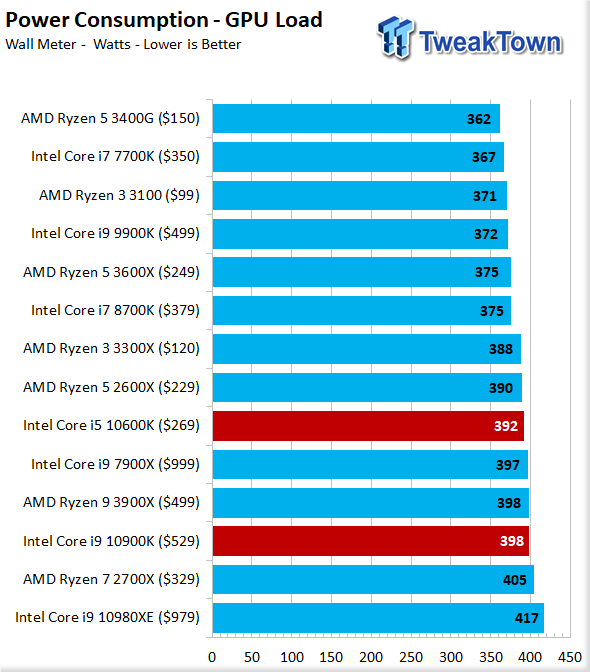
Testing synthetic GPU stress only is an excellent way to show the overhead the CPU adds, as the GPU does not pull more power after it reaches steady state. Here we see the 10900K platform pulling 398W, which is just below the 2700X and 10980XE. However, it does match the 3900X and the 7900X, so it's not even alarmingly higher like we saw with the strictly CPU load testing.
Thermals
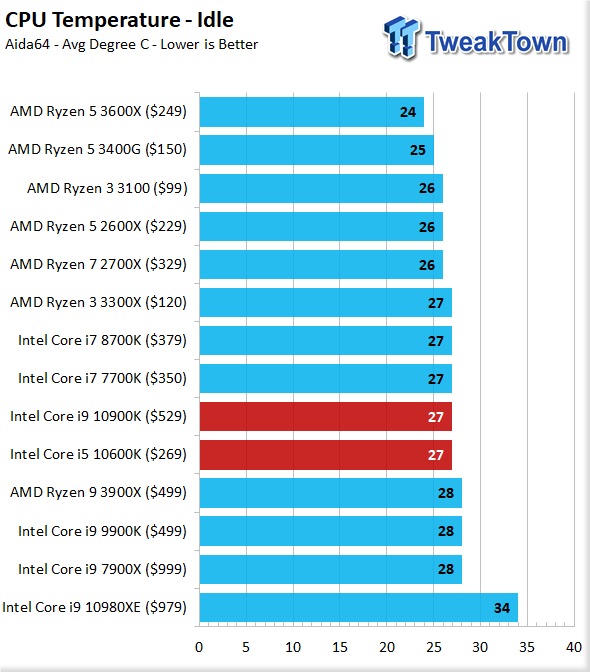
Idle temps for the two new chips are 27C for both, matching much of the pack with only the 3600X and 3400G achieving noticeable lower results. However, idle is one thing, but let's see how they scale when put under the fire.
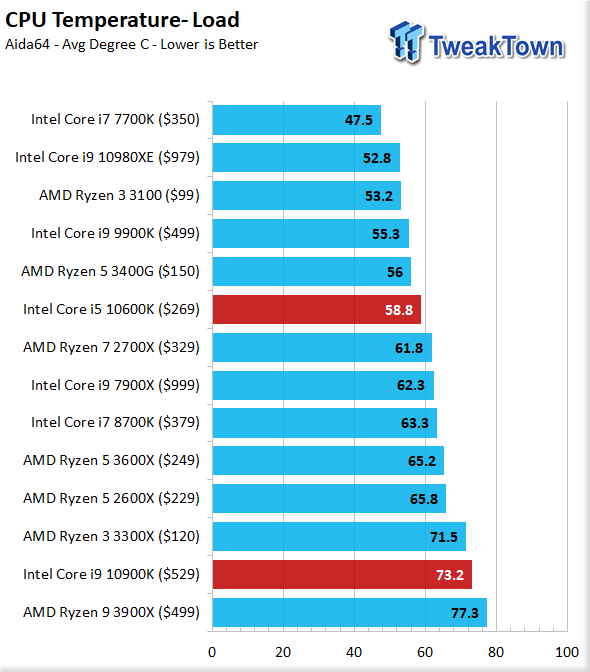
We see the temps jump up, and the field spread a bit by loading each CPU up with a full burn-in load. The 10900K now tops at an average of 73.2C. This places the 10900K right below the 3900X, which averages 77.3C under our stress testing. The 10600K with its lower core count tops the scale at 58.8C, which is well below the 3600X and the 8700K it was fighting against.
Overclocking
Overclocking is always interesting on new platforms, and this is no different from Z490. However, I cannot help but feel like we are heading more towards boosting smaller numbers of cores vs. overclocking all-core as each generation marches on. This is due to several factors, including that achieving higher frequencies on the tighter nodes will be more difficult, which is why we see heavier reliance on various boost algorithm to accomplish the most frequency possible.
This also means that the days of all core overclock over the boost clocks are slowly fading, at least when considering ambient cooling. This does not apply to the XOC crowd, which is an admittedly niche part of our community.
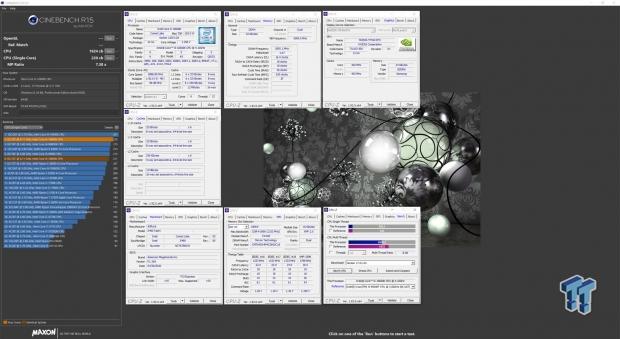
First on the bench for overclocking is the 10600K, which we saw a maximum stable clock of 5Ghz, with a set 1.32VCore. This is not a bad result and gave us a robust gain and a 1T increase of 5% and an nT increase of 9% above the stock result. This places it above the 9900K and 3900X, which is a reasonably good overall result.
Now let's see what the new king of Intel's mainstream platform has to offer.
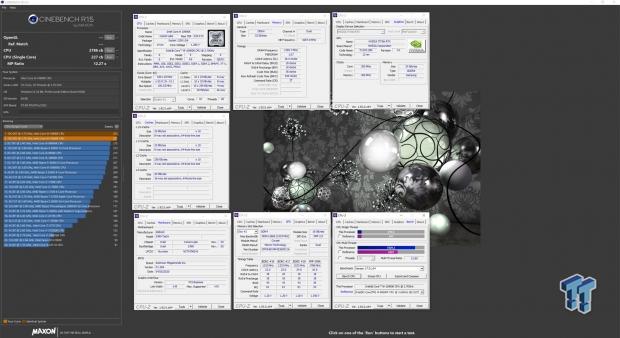
The 10900K achieved a 5.2GHz all-core clock, which means we will lose a bit of the 1T performance as we see it drop from 231 to 227. The multi-core, however, raised from 2659 to 2786, which is a small gain of 5% when considering the thermal difference for a fixed overclock.
As I mentioned before, this now is a closer experience to what we see with Ryzen, where the top chips may be better just letting the boost work its magic. Pushing past what Intel has already squeezed from these parts will be marginal at best and, depending on your point of view, may be a detriment when considering 1T performance along with the thermal impact.
No, your new 10900K is not going to run 93C stock
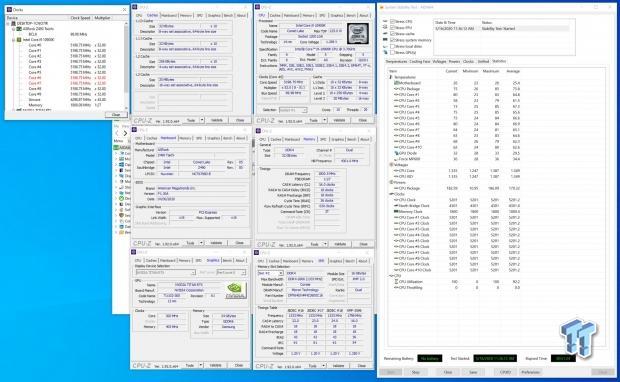
We saw a "leak," which spurred tons of news articles covering how the 10900K runs at 93C+ and chugs 250+ Watts, so I felt like there were some things that need to be cleared up. First off, an FPU test like what was used is more of a power virus loading and more akin to a cooler test than to show what a user will experience under heavy real-world loading.
This is why you see the image above as I run a mixed stress test more representative of an actual heavy loading scenario, which still uses AVX/FPU instructions. Now, mind you, I manually overclocked and even gave a buffer of voltage to pump heat a bit more. I am on a 360mm AIO liquid cooler and even at 4.2GHZ with more voltage than necessary (1.35V set in UEFI) to push more heat. You can see that contrary to the leaked image, I hold a stable 5.2GHz under that loading, but I also did so while averaging a package temperature in the mid 70's with small spikes in the 80's range.
Now let's look at the thermal imaging and differences between an FPU load and the loading I use.
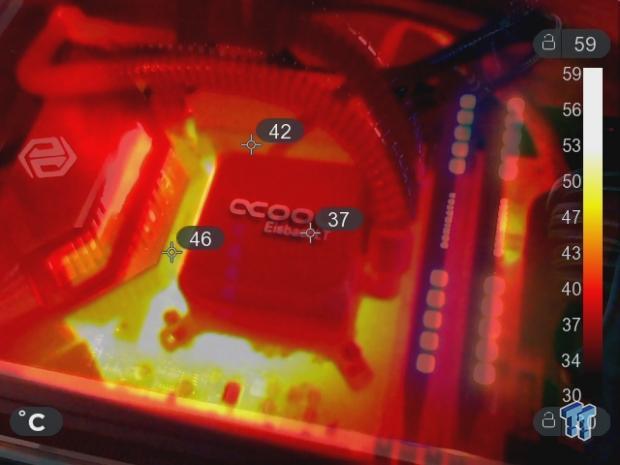
We have the CPU under the power virus FPU load, and as expected, the load is designed to push just a ton of power into the CPU by forcing an unrealistic loading scenario. I have no problem with people running this sort of load to validate a VRM cooler or even a CPU cooler, but to use this as a metric to gauge the thermal performance of a CPU carries the stench of nefarious motives.
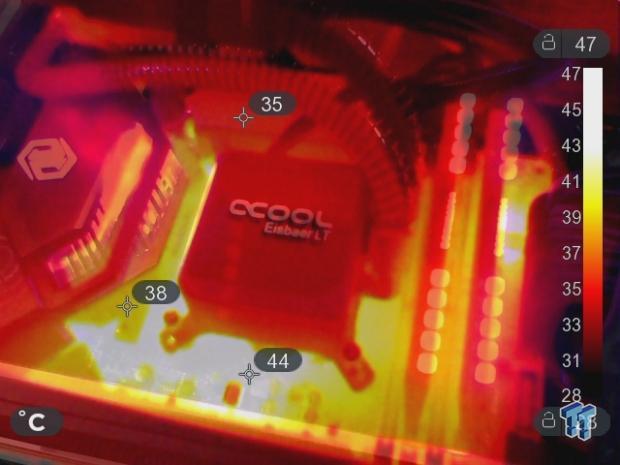
Here we have the thermal image running the stress test loading, how I do it. As you can see, all areas are now alive as we are stressing the memory, cache, and FPU/CPU. Here you can also see the PCB and traces between the CPU socket and memory now show some heat as the stress test puts everything to work.
As you can see, this visually explains my methodology for my thermal testing as while FPU exists and has its purpose. It can be used to unfairly represent a product or even throw shade on a new product pre-launch just to create bad press and rumors.
And with that I think we have seen enough of what these new 10th gen parts have to offer, I say its due time we pull this one into the pit lane and wrap up our experience.
Final Thoughts
When hearing about the new 10th gen, I was admittedly excited as the prospect of a 10-core intel part in the mainstream is exciting. The thermal density was an admitted concern at first light, but Intel explained the thinner die as we had briefing calls, which helps with heat dissipation. This alleviated some of the thermal worries brought on by 9900K, which had a thicker diffusion barrier causing the higher thermals.
After testing, I think the 10th gen parts are robust and well-positioned entries into the mainstream space and help intel extend its lead on gaming performance slightly, even if that lead is only at 1080p. Higher resolutions and that claim start to fall on its face as the GPU suddenly becomes the bottleneck, and the CPU is along for the ride.

What we like
Price Per Core: We now have a six-core part that beats the 8700K at roughly 66% of its price point. The 10900K takes the existing 9900K and essentially adds two more cores hyperthreaded and even pulls some wizardry in boost clocks to give it an extra edge.
Frequency: I would love nothing more than to call BS on marketing, but frequency still does matter, at least in a way. Architectural efficiency is starting to nullify this argument in some ways, but having a frequency at 5GHz+ still does a lot to give you a performance edge.
Fastest Gaming CPU: This is still a nebulous claim as it depends on the resolution. I know plenty of people rocking 9900K or 8700K CPUs that game at 1440P or higher, so that performance leadership is heavily dependent on users running 1080p. Once the resolution scales upwards, it can become a wash.
What do we think could be better?
New Architecture/Node: 14nm is a very mature node, long past its shelf life, even if Intel has done an excellent job of optimizing it and squeezing every drop of performance it has to offer. We are long overdue for Ice lake/10nm now, and if rumors hold, the successor to the chips we see today is purported to be rocket lake and said to be 14nm as well. I am simply not sure if intel can squeeze much more out of 14nm, at this point, but time will tell.
More cores/threads: Ryzen has gone crazy, with core counts on the mainstream with Ryzen 3000 scaling to 16 Cores with SMT. Intel offering 37% less total core density is noticeable and something I think Intel has the ability to do. However, I do not believe they could do it on 14nm, so I guess this one would follow the first.
PCIe 4: PCIe 4 is still new, yes. However, I do think with storage solutions coming into play that can utilize that bandwidth and graphics cards as well; Intel has to really step up on the next generation.
The new Intel 10th gen Comet Lake-based CPUs are real powerhouses, and indeed the 10900K as of the time of writing is the fastest gaming processor on the market. However, Ryzen 4000 is coming this year according to AMD, and Intel is going to have to hope their frequency leadership holds out. Otherwise, they have an even more intense battle coming to their home territory.
I will say I walk away at the end of this review, impressed with what Intel has been able to pull off. But Intel knows now that they cannot rest on their laurels and must get something moving with their PCIe 4 feature set, along with enhancing core counts. Otherwise, they may lose the last bastion of performance leadership in their arsenal.
Performance |
96% |
Quality |
98% |
Features |
94% |
Value |
93% |
Overall |
95% |
Intel has pulled another rabbit out of its hat with Comet Lake. The new 10th gen CPUs squeeze 14nm even further to gain more speed and cores at all price levels. Gamers looking for the absolute fastest processor will find some great performance from these new entries.

Similar Content
Related Tags

